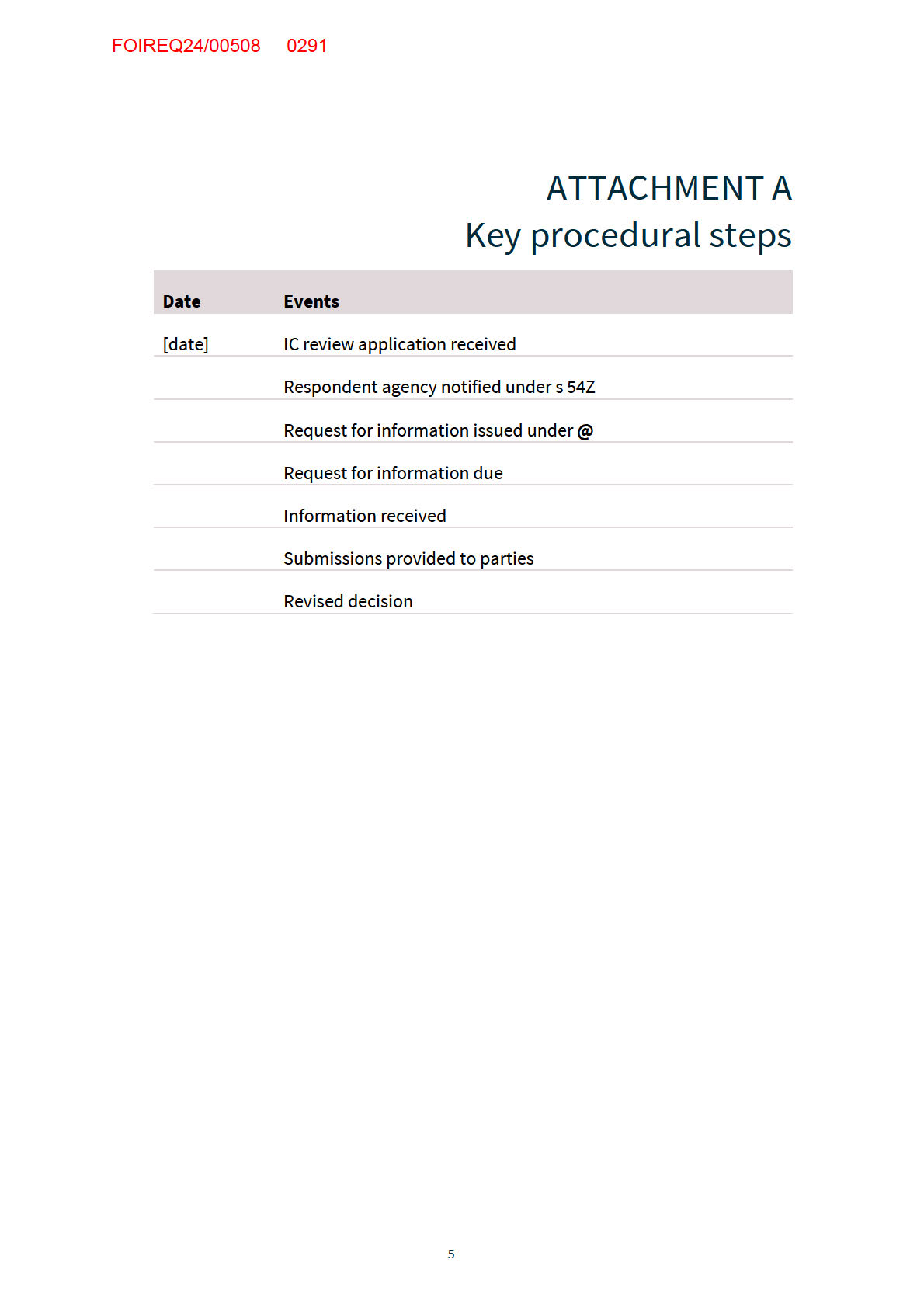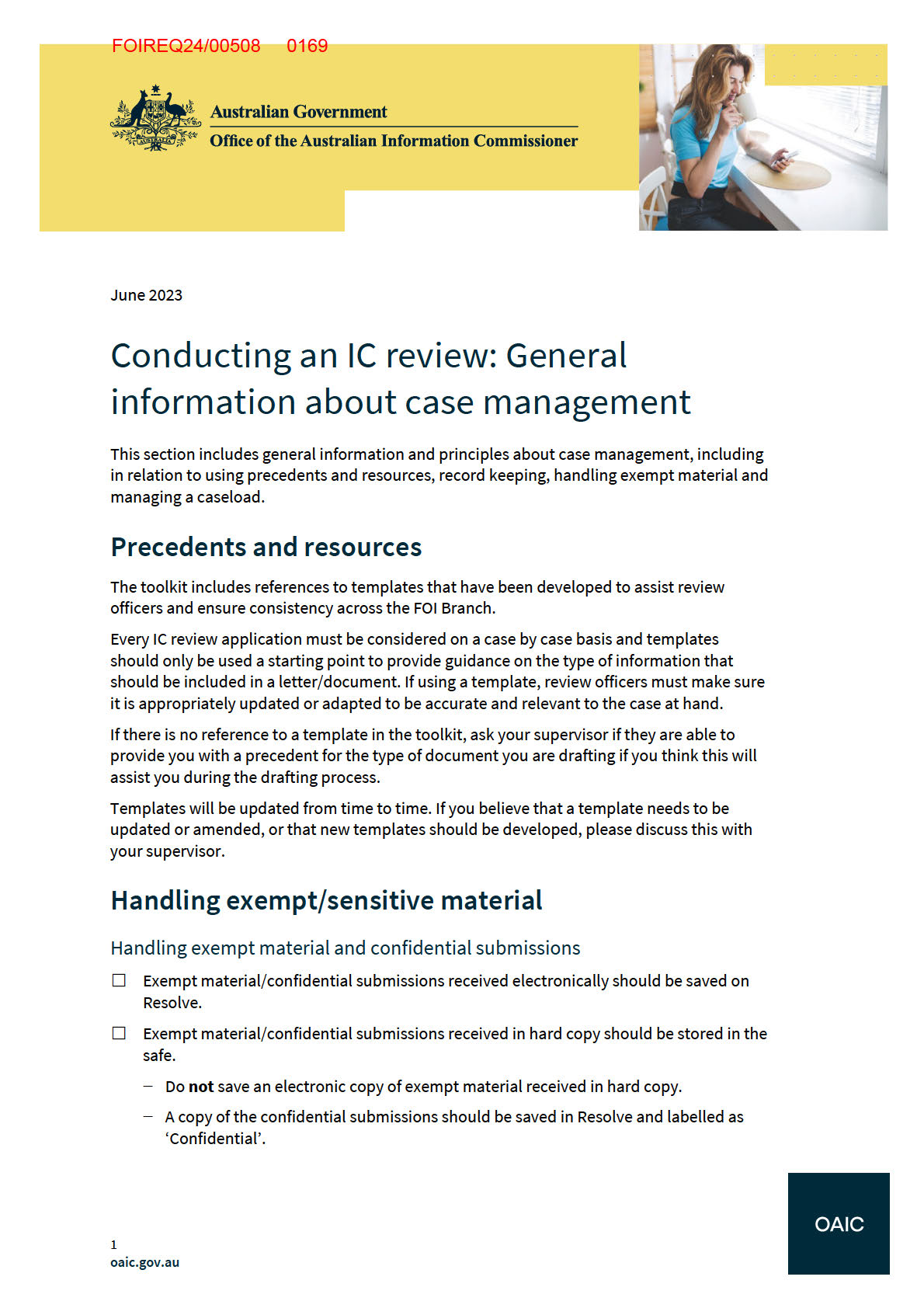
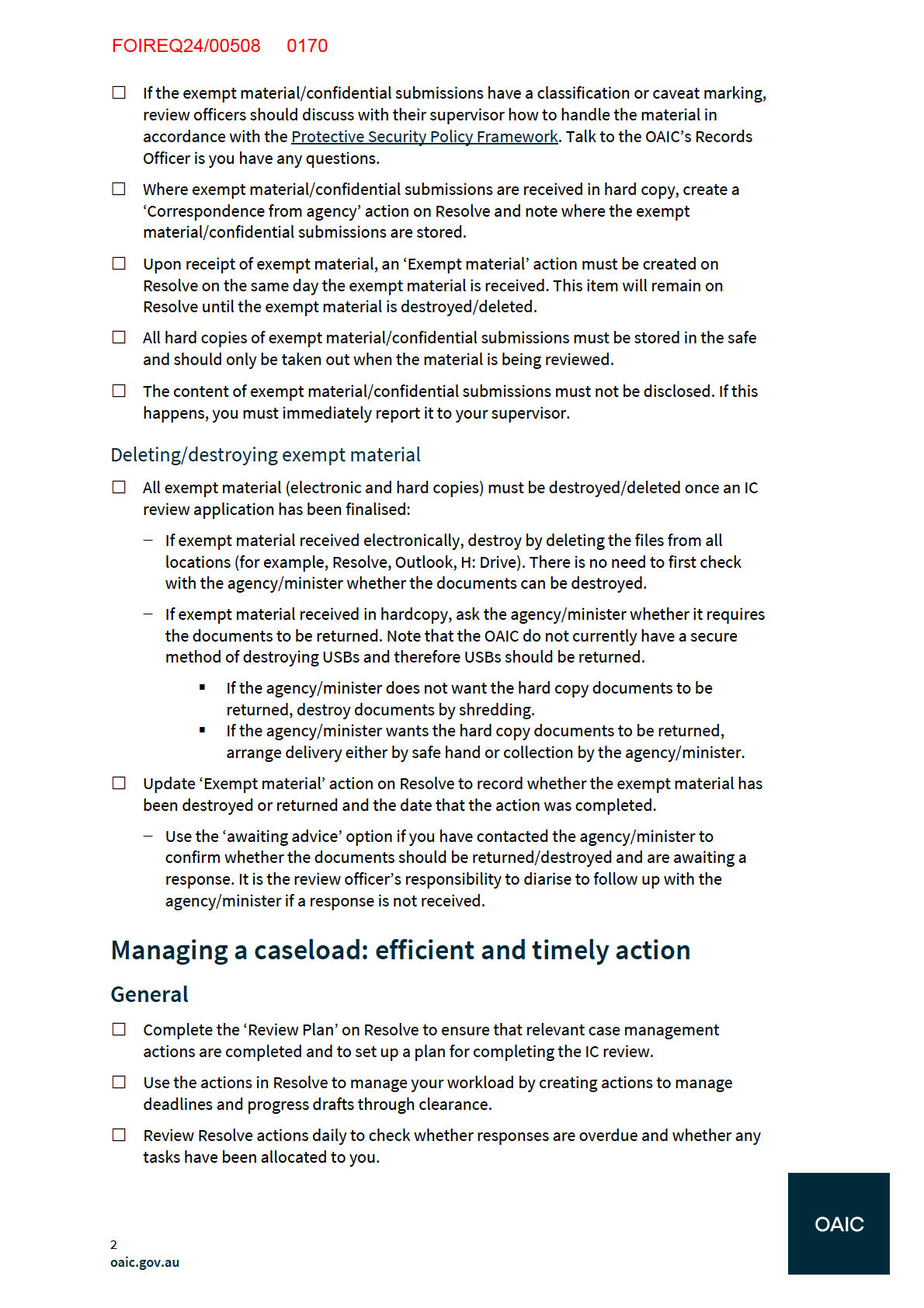
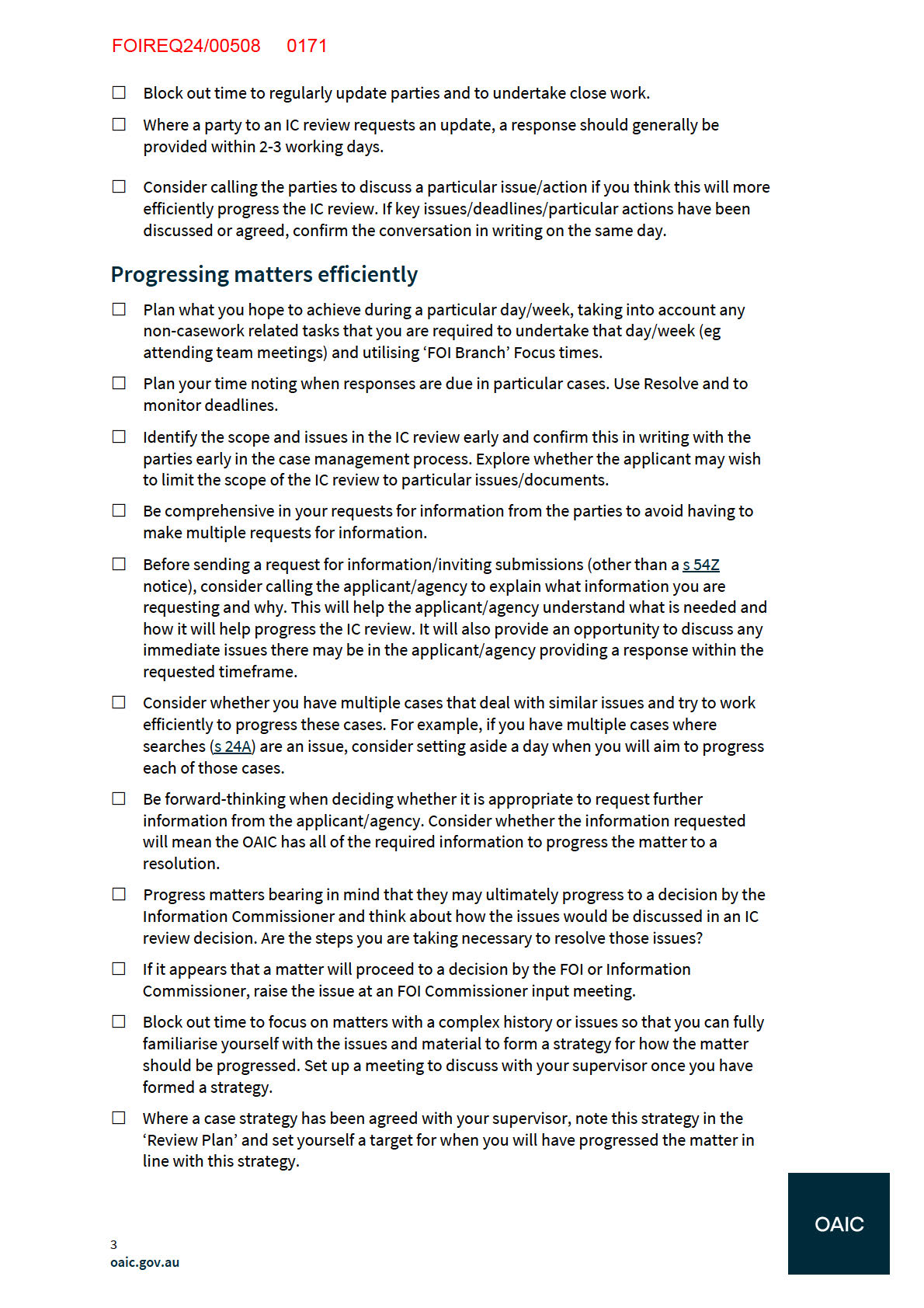
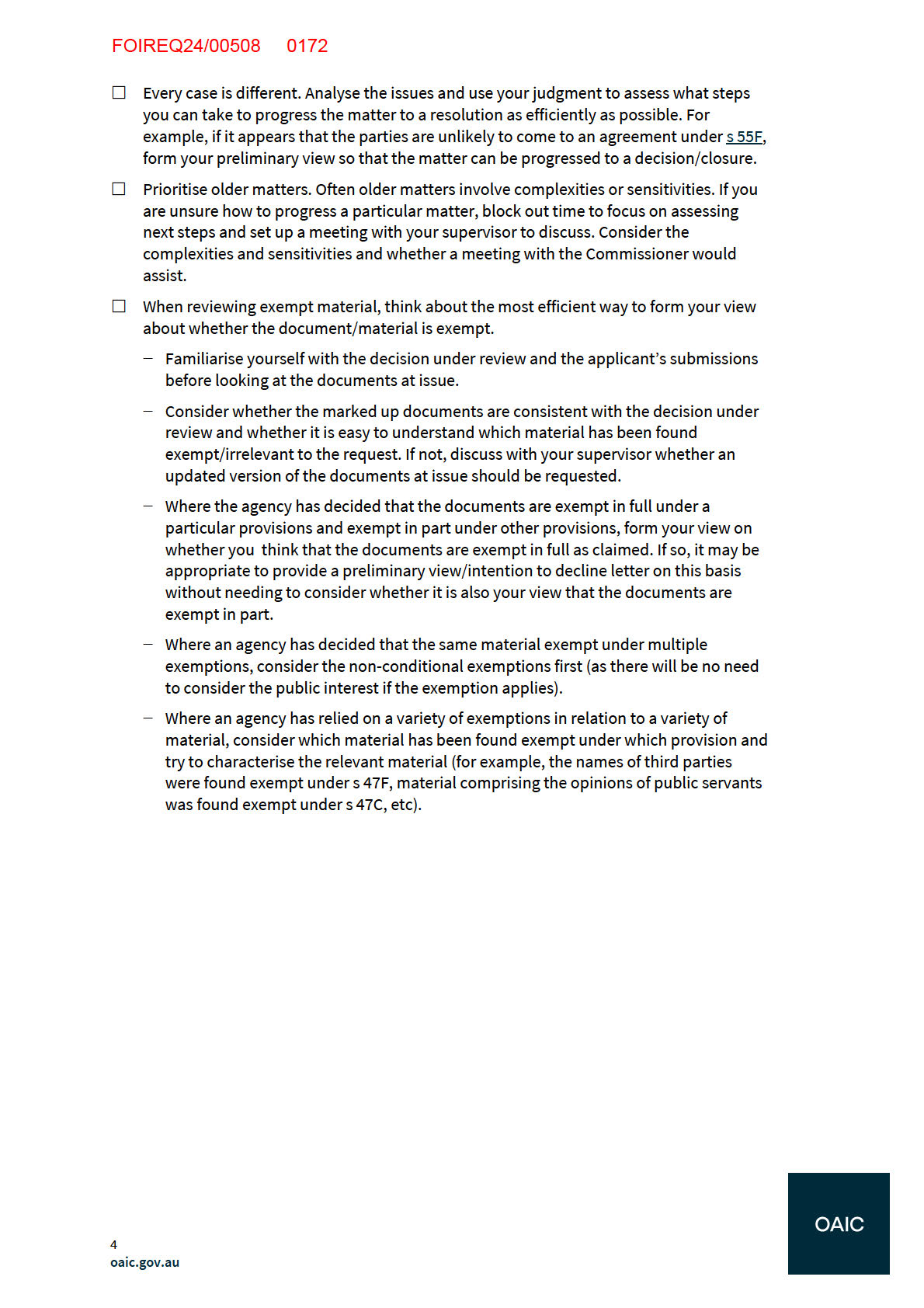
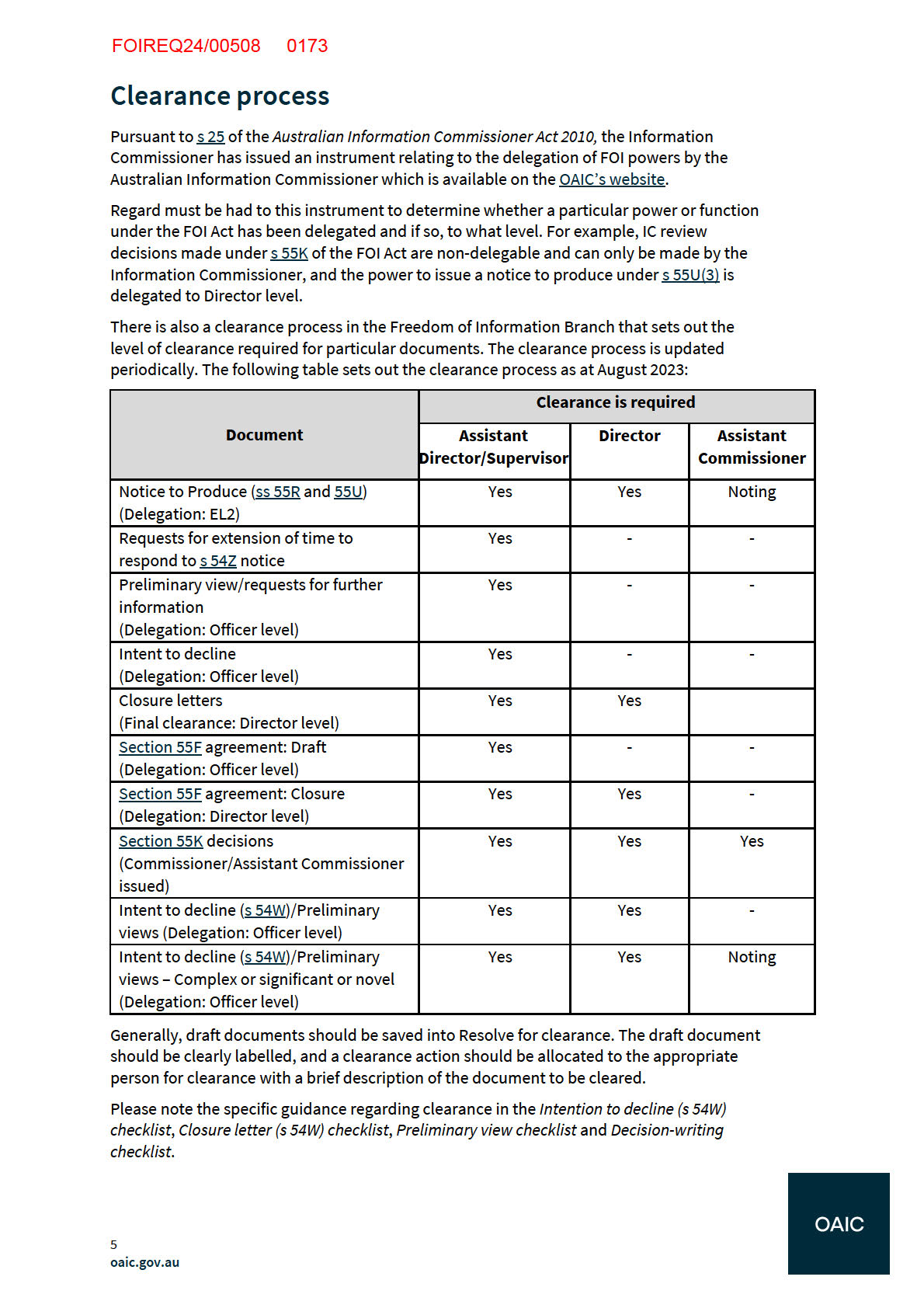
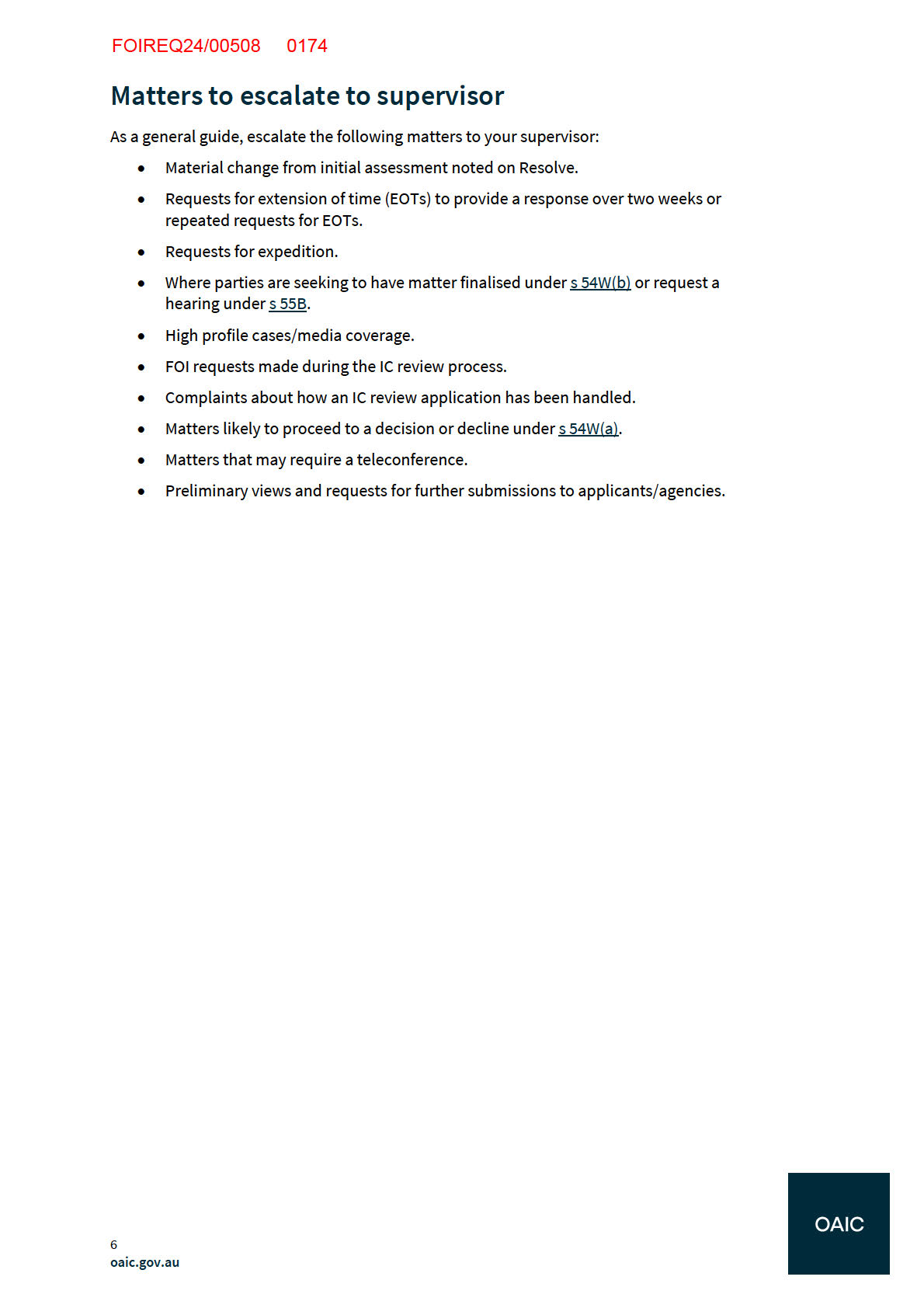





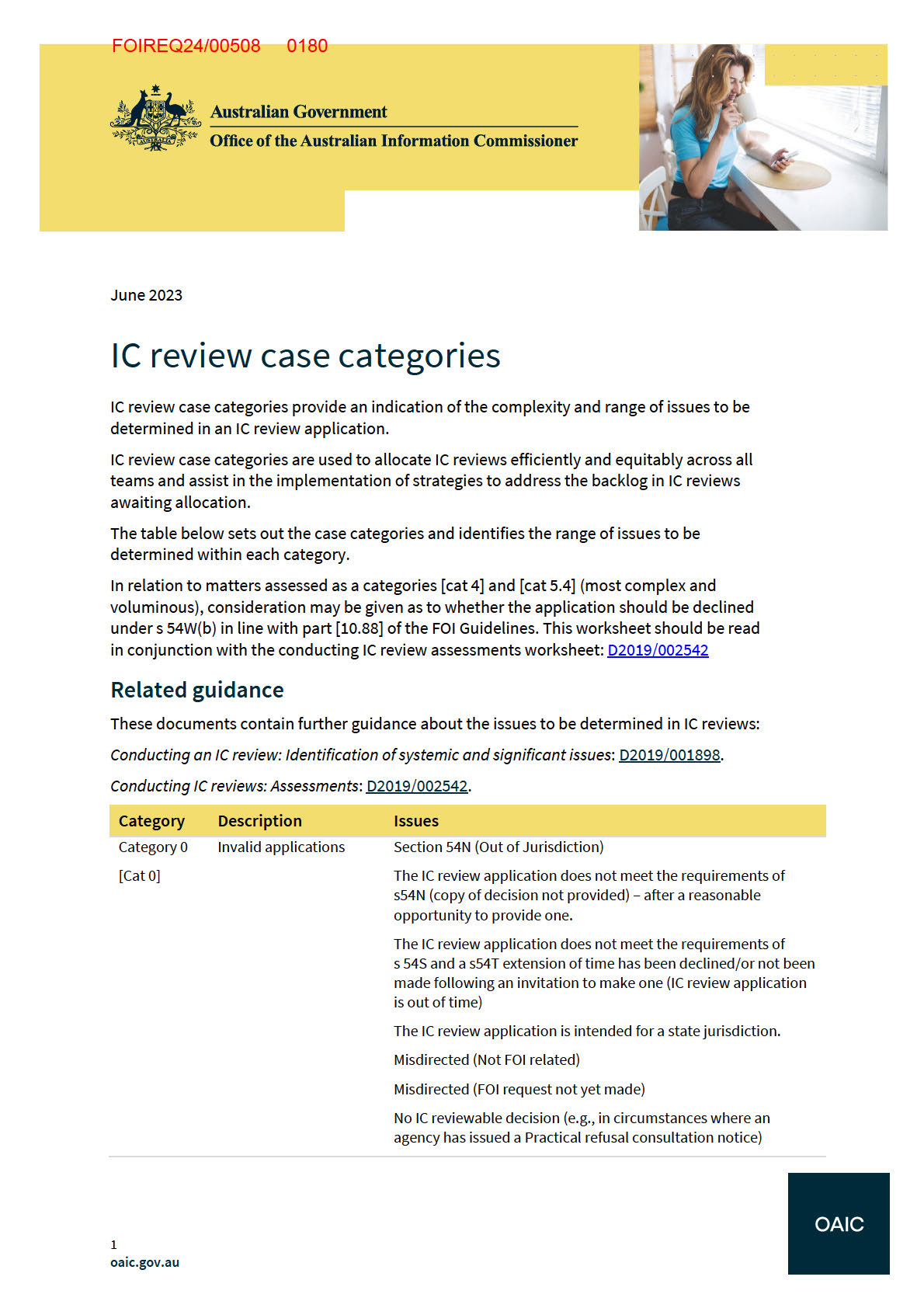
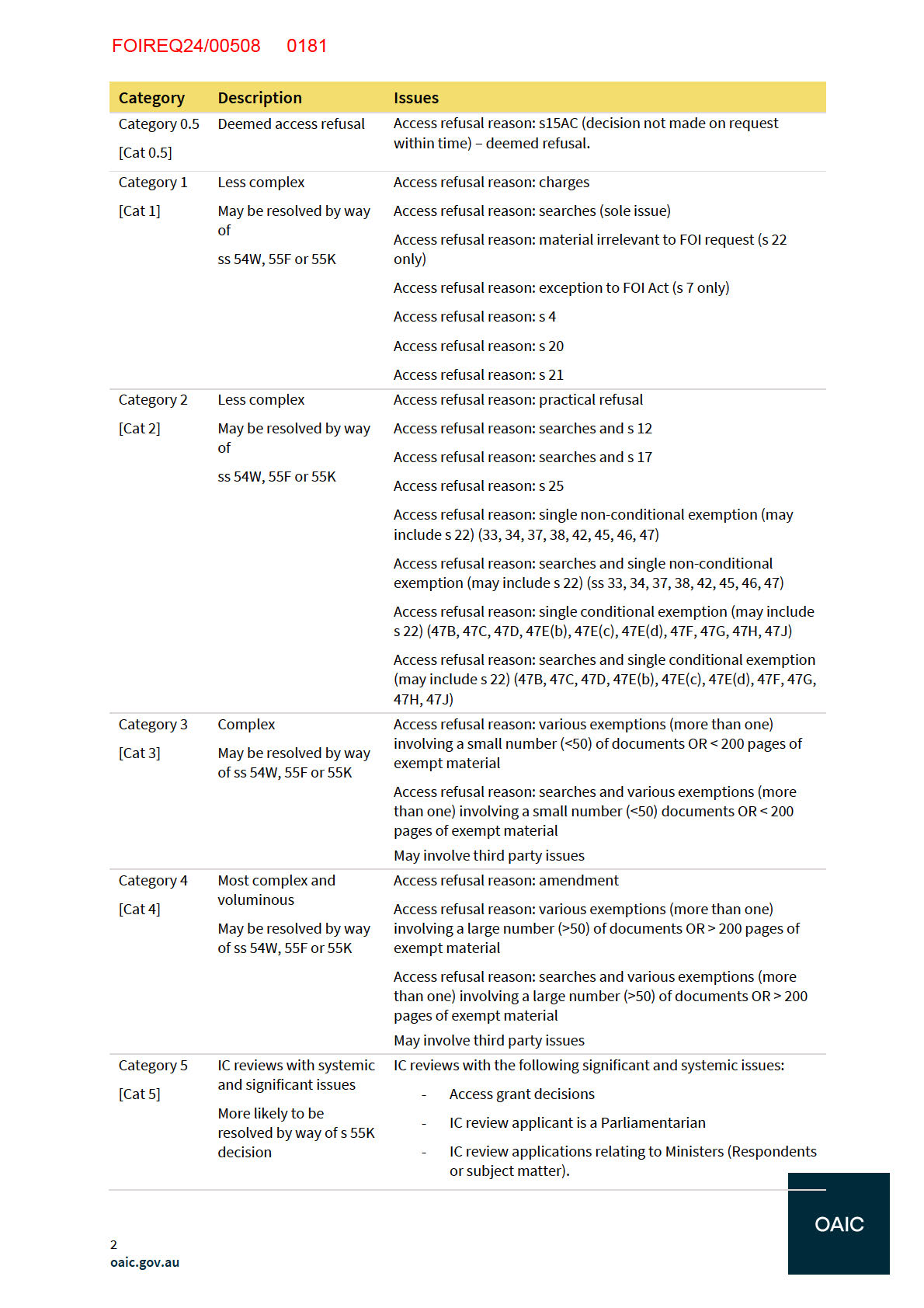
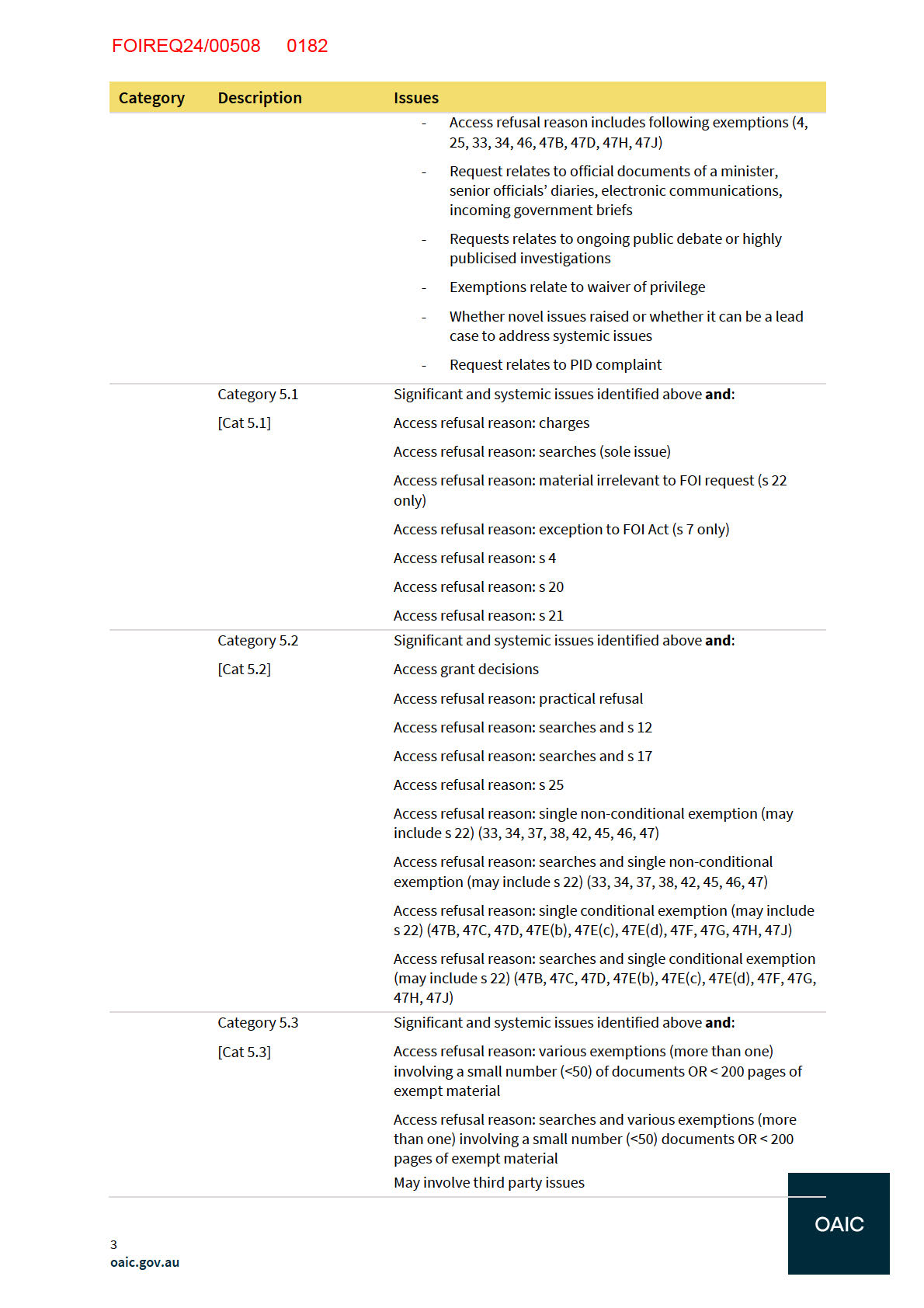
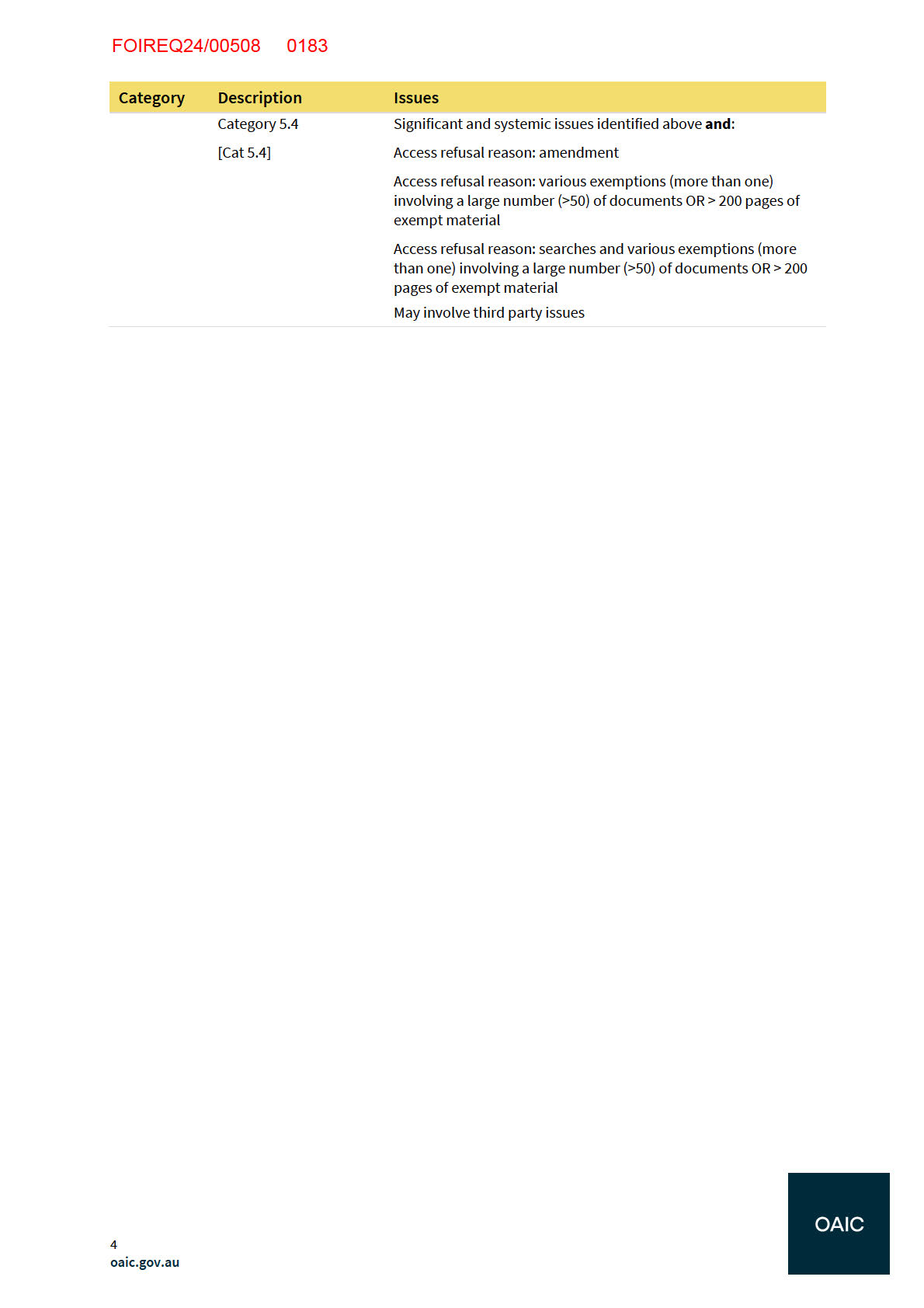

FOIREQ24/00508 0184
Style Guide
Prepared by Strategic Communications
16 June 2021
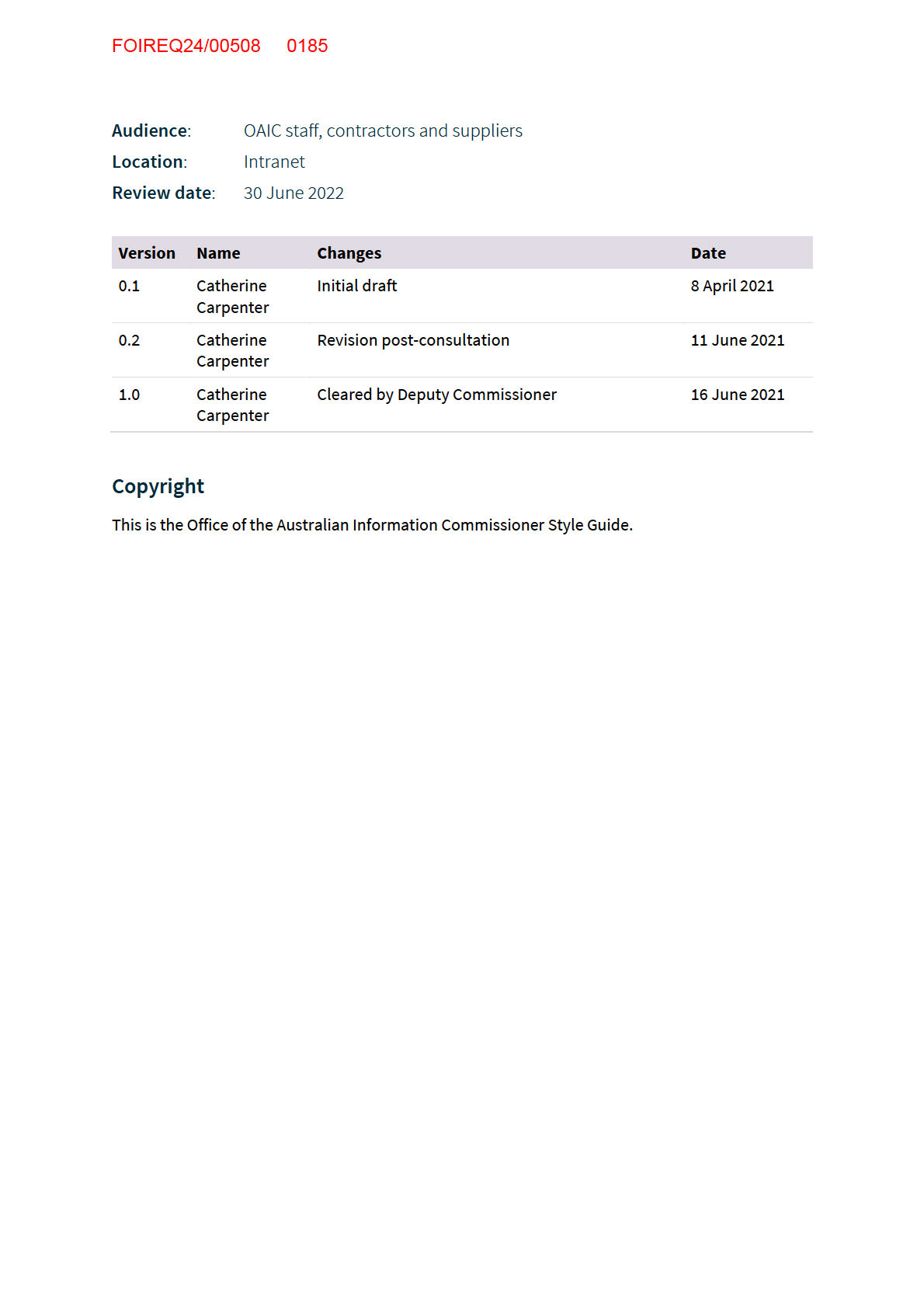
FOIREQ24/00508 0186
Welcome to the new OAIC Style Guide
The Strategic Communications team is pleased to share the new OAIC Style Guide, which replaces
the 2012 Writing style guide. The Style Guide provides comprehensive guidance whether you’re
writing a webpage, report, submission or presentation. We encourage you to familiarise yourself
with the content of our Style Guide – and use it to resolve your queries about writing style.
We welcome your feedback on the Style Guide. Tell us how we can make the Style Guide more
helpful – and let us know what’s missing – by emailing us at xxxxxxxxx@xxxx.xxx.xx.
Structure
The OAIC Style Guide has been structured in the same way as the Australian Government digital
Style Manual which was released in September 2020.
Style Guide content has been linked to the digital Style Manual so you can access more detailed
information easily.
Blue boxes summarise content sections.
Yellow boxes highlight useful information and tips.
Grey boxes provide examples.
Links in the Style Guide point to:
1. Further guidance in the Style Guide
2. Guidance in the digital Style Manual
Legal citations
This Style Guide contains guidance on how to cite legal material which is tailored to the content
we publish, such as guidance and advice, reports and assessments. See Legal material below.
For specific guidance on how to cite legal material in legal writing and research, you may wish to
use the 4th edition of the
Australian Guide to Legal Citation (AGLC4).
OAIC Style Guide 2021
Page 1
FOIREQ24/00508 0187
Contents
Part A: Format, writing and structure
5
Clear language and writing style
5
Plain language and word choice
5
Abbreviations
7
Acronyms and initialisms
8
Contractions
10
Latin shortened forms
11
Sentences
12
Types of words
14
Voice and tone
15
Inclusive language
18
Aboriginal and Torres Strait Islander peoples
18
Age diversity
19
Cultural and linguistic diversity
19
Gender and sexual diversity
20
People with disability
22
Structure
23
Types of structure
23
Headings
24
Links
26
Lists
27
Paragraphs
29
General conventions, editing and proofreading
30
Part B: Style rules and conventions
30
Editing and proofreading
30
Italics
30
Punctuation and capitalisation
32
Spelling
33
Names and terms
35
Australian place names
35
Government terms
36
Commercial terms
38
Dates and time
38
Organisation names
41
OAIC Style Guide 2021
Page 2
FOIREQ24/00508 0188
Numbers and measurement
44
Choosing numerals or words
44
Currency
46
Measurements and units
46
Ordinal numbers
47
Percentages
47
Punctuation marks
49
Apostrophes
49
Brackets and parentheses
52
Colons
54
Commas
55
Dashes and en dashes
60
Exclamation marks
63
Ellipses
63
Forward slashes
64
Full stops
64
Hyphens
66
Question marks
70
Quotation marks
71
Semicolons
73
Referencing and attribution
75
Author–date
75
Documentary–note
75
Legal material
76
Titles, honours, forms of address
89
Awards and honours
89
Judiciary
89
Members of Australian parliaments and councils
90
Appendices
92
Appendix A: Plain language word choices
92
Appendix B: Abbreviations
94
Appendix C: OAIC templates
97
OAIC Style Guide 2021
Page 3
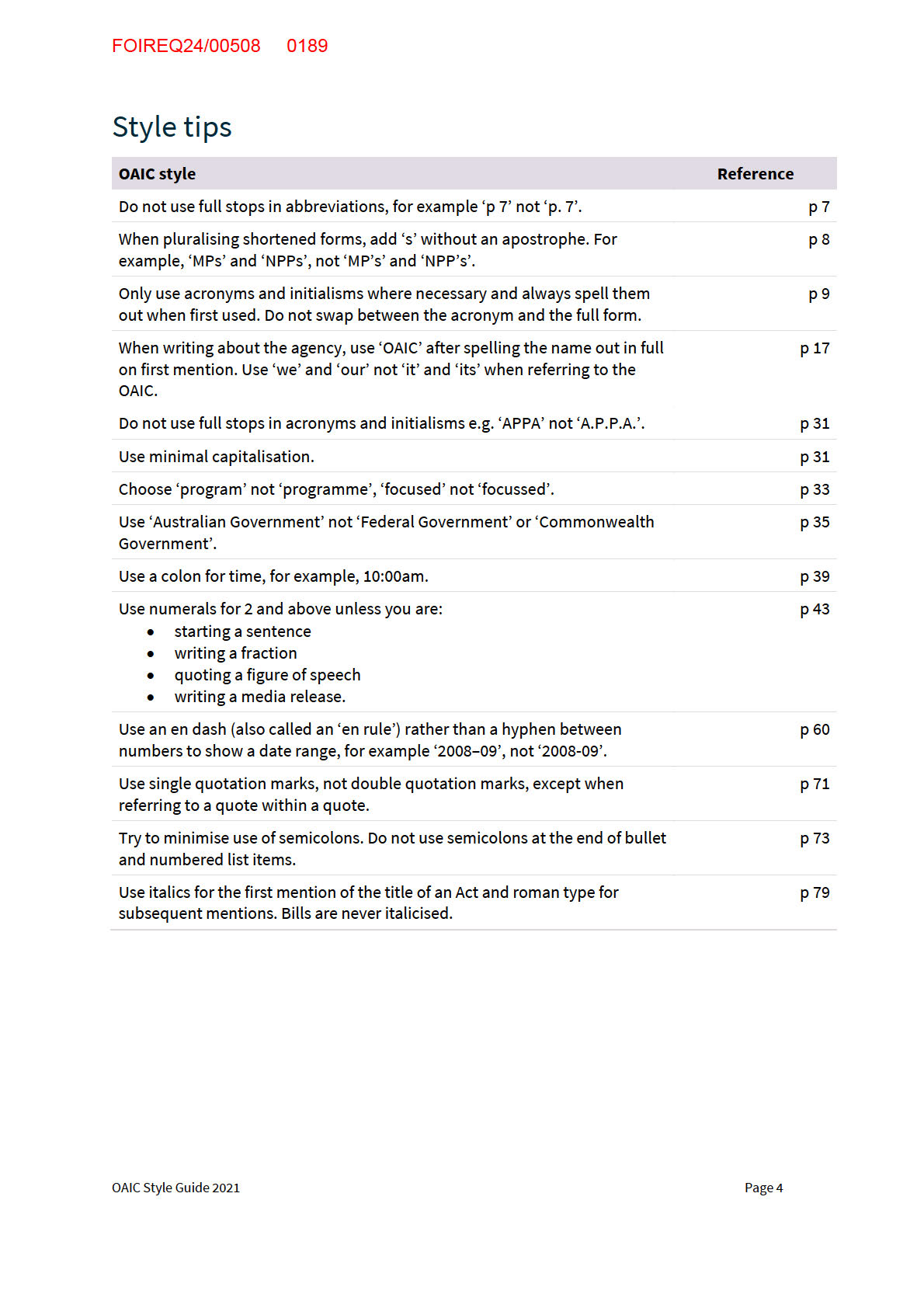
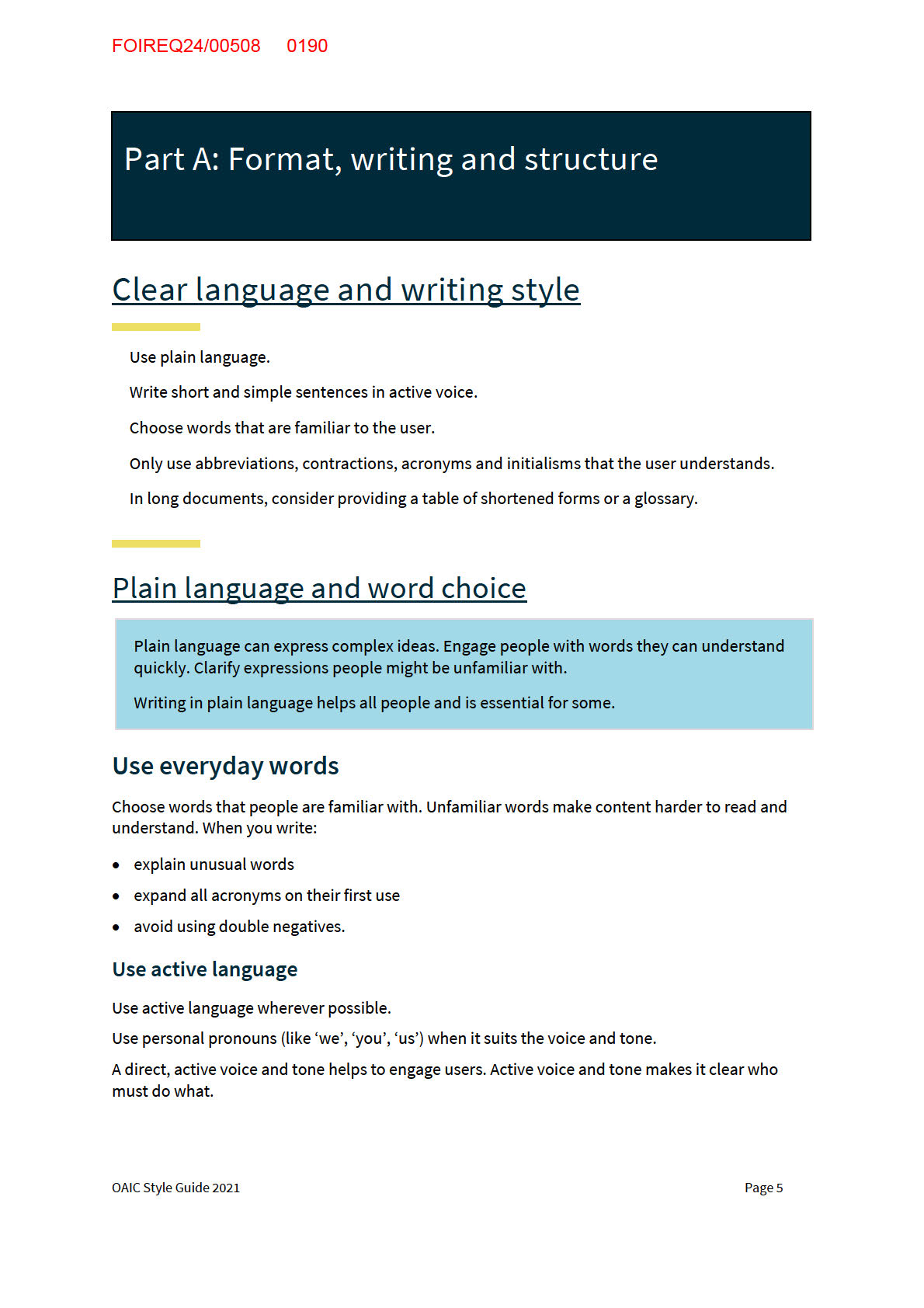
FOIREQ24/00508 0191
Write this
We will assess your application in 30 days.
Not this
Applications are assessed in 30 days.
Passive voice
Only use the passive when:
• you have to be diplomatic and the active would sound too direct
• you have one subject that you would otherwise repeat endlessly.
Use inclusive language
People can relate to content when it uses inclusive language. Choose words that respect all
people, including their rights and their heritage.
Use language that is culturally appropriate and respectful of the diversity of Australia’s
peoples.
Only refer to age when it is relevant and necessary.
Use gender-neutral language and preferred pronouns.
Focus on the person, not the disability. Mention disability only if it is relevant and
necessary.
Choose simple words, not complicated expressions
There is usually more than one way to express something. Find the simplest, clearest option.
Replace longer words and phrases with simpler alternatives. See Appendix A: Plain language word
choices.
Keep words and phrases with special meaning to a minimum
People can be unfamiliar with words you need to use, for example:
• official titles
• Acts of parliament
• names of organisations.
For names and terms with special meaning, follow style rules and conventions.
Be selective about shortened forms, such as abbreviations, acronyms and initialisms.
OAIC Style Guide 2021
Page 6
FOIREQ24/00508 0192
Shorten only words and phrases that are well known or used many times in your content.
Always consider user needs and avoid using shortened forms when writing for the public
which may be seen as jargon.
The Australian Privacy Principles are principles-based law.
Consumer Data Right
The Consumer Data Right was introduced on 1 July 2020. To help consumers become
familiar with the concept, government agencies have been asked to use the term in full
wherever possible. The initialism ‘CDR’ may be used to refer to specific elements of system –
for example, the CDR Rules, CDR Privacy Safeguards and CDR data – or where space for
content is limited, such as in headings.
Shortened forms can help people read and understand content, but too many can be difficult to
follow. In content with many specialist terms, reserve shortened forms for the most frequently
used terms only. Spell out other terms in full.
Spell out shortened forms the first time you use them. In a long publication, spell them out
at the beginning of each section.
The Notifiable Data Breaches (NDB) scheme began on 22 February 2018.
Abbreviations
Abbreviations are shortened words. They can hinder people’s understanding, so they have
limited uses.
Limit the use of abbreviations
Abbreviations contain the first single letter or first few letters of a word. They don’t include the last
letter of a word.
cont (for continued)
fig (for figure)
p (for page)
tel (for telephone)
para (for paragraph)
co (for company)
Abbreviations are generally not good for readability and can be misunderstood. Avoid using them
in general text where possible.
OAIC Style Guide 2021
Page 7
FOIREQ24/00508 0193
Abbreviations are useful in very limited circumstances:
• in a table or chart, where space is unavailable for the full form of the word – provide a note
under the table or chart giving the full form
• when using ‘cont’ to show continuing text in another part of content (for example, on another
page of a print newsletter) – the full form of the word is more helpful where space allows.
Don’t put a full stop after most abbreviations
Don’t place a full stop after an abbreviation unless it ends the sentence.
See Organisation names
See Months and days of the week
Unlike other shortened forms, some Latin shortened forms have full stops.
Place full stops after each letter in ‘i.e.’ and ‘e.g.’ so that screen readers can announce them.
Do not use a comma after ‘e.g.’ or ‘i.e.’ in a sentence.
Add ‘s’ to create plural abbreviations
Add an ‘s’. There is no need for an apostrophe.
APPs
MPs
Acronyms and initialisms
Acronyms and initialisms are shortened forms. They replace full names and special terms in
text. Use them only if people recognise and understand them.
See Appendix B: Abbreviations
Choose acronyms and initialisms people will recognise.
Acronyms are terms that comprise initial letters and you can pronounce as a word.
Qantas
Anzac
TAFE
OAIC Style Guide 2021
Page 8
FOIREQ24/00508 0194
Initialisms are terms that comprise initial letters and you pronounce as letters, not a word.
CDR
GST
NDIS
Acronyms and initialisms are common in formal content. If understood by users, they can make
content easier to use.
CSIRO for ‘Commonwealth Scientific and Industrial Research Organisation’
Explain acronyms and initialisms to all users
People unfamiliar with certain terms might not understand their shortened forms. Acronyms and
initialisms might also be misread by screen readers.
Spell out acronyms and initialisms the first time you use them. In a long publication, spell
them out at the beginning of every section.
The Department of Veterans’ Affairs (DVA) sent a letter to the client in June.
Check the correct shortened form for government organisations
The names of government departments are often shortened, but not always in the same way.
DFAT (Department of Foreign Affairs and Trade)
Home Affairs (Department of Home Affairs)
Rather than using acronyms or initialisms, it can be easier for people if you:
• spell out the agency’s name in full the first time you use it
• then use the generic name (‘department’, ‘agency’, ‘bureau’) afterwards.
For content with lots of acronyms and initialisms, provide a glossary at the end or on a
separate webpage. Use a hyperlink in the text to help people access the glossary.
Don’t end acronyms and initialisms with a full stop
Don’t place a full stop after the acronym or initialism unless it ends a sentence.
OAIC Style Guide 2021
Page 9
FOIREQ24/00508 0195
Use capitals for most acronyms and initialisms
If the acronym or initialism represents common nouns, don’t begin each word of the full form with
a capital letter.
‘privacy impact assessment’ for PIA
‘privacy management plan’ for PM
‘tax file number’ for TFN
If the acronym or initialism represents a proper noun, start each word with a capital letter
(excluding words such as ‘of’ and ‘and’).
OPC [Office of Parliamentary Counsel]
Avoid plural and possessive forms on the first use
Avoid using the plural or possessive of an acronym or initialism when you define it. This makes it
easy for users to recognise the shortened form in later content.
It’s compulsory for certain businesses to have an Australian Business Number (ABN). The
Australian Business Register manages applications for ABNs. [There’s no need to use an
apostrophe before the ‘s’ for ABNs as the term is plural, not possessive.]
The Australian National University (ANU) has a new student policy. The ANU’s policy is
popular with its staff and students. [Use an apostrophe before the ‘s’ to show that the ANU
owns the policy.]
Contractions
Contractions are shortened words. People will read and understand them depending on
their context. Avoid them in formal content.
Shorten single words and grammatical phrases with care
Single-word contractions use the first and last letters of a word and sometimes other letters in
between. Avoid using contractions of single words in more formal content such as ministerial
briefings. The exceptions are contractions such as ‘Dr’ and other titles.
Cth for ‘Commonwealth’
Ltd for ‘Limited’
OAIC Style Guide 2021
Page 10
FOIREQ24/00508 0196
Don’t place a full stop after contractions. The exception is when the contraction ends a sentence
and isn’t followed by another punctuation mark.
Number is shortened to ‘no.’ in legislation titles and a full stop is used after the contraction.
This is an exception to the rule that a full stop should not be placed after a contraction
unless the contraction ends the sentence.
Grammatical contractions join 2 words. They use an apostrophe to show that there are missing
letters.
aren’t (are not)
don’t (do not)
isn’t (is not)
it’s (it is)
See Apostrophes show contractions
Grammatical contractions are not generally used in formal content. You can use them in less
formal content which aims to create:
• a conversational tone (for example, in a newsletter)
• a friendly or collaborative tone (for example, in manuals).
Don’t end contractions with full stops
Don’t place a full stop after contractions. The exception is when the contraction ends a sentence
and isn’t followed by another punctuation mark.
Latin shortened forms
Use English rather than Latin shortened forms, except in some cases.
Rather than using ‘e.g.’ or ‘i.e.’ write the English words out in full. Write ‘for example’ and
‘that is’ instead, particularly in more formal publications.
Where you need to show an error in a quotation, use ‘[
sic]’ which means ‘in the original’. Place it
directly after the error.
Written late at night, the report began, ‘The office was previously in Melberne [
sic].’
OAIC Style Guide 2021
Page 11
FOIREQ24/00508 0197
Sentences
Clear sentences in active voice improve readability. Keep sentences short to help people
scan content.
Write plain language sentences
Keep sentences to an average of 15 words and no more than 25 words, especially for digital
content. Too many words, phrases and clauses affect people’s ability to scan sentences.
Sentences over 25 words can usually be broken up using different techniques, like using lists.
Use active voice
Use active rather than passive voice. Active voice helps users understand who is doing what. It can
also help people know exactly what their responsibility is.
Eligible students can access the subsidy by completing the application. [Active voice]
The subsidy can be accessed by completing the application. [Passive voice]
The difference is clearest with action verbs:
• Active voice: the grammatical subject is performing the action in a sentence.
• Passive voice: the grammatical subject is undergoing the action.
Active voice: The student filed the application. [‘The student’ is the grammatical subject,
who did the filing. ‘The application’ is the object.]
Passive voice: The application was filed by the student. [‘The application’ is the
grammatical subject, but did not do the filing.]
Construct positive, unambiguous sentences
Words, phrases and sentences can have more than one meaning. Write exactly what you mean and
construct your sentences so there is no ambiguity. Write sentences so they are positive rather than
negative.
Like this
Include these documents when you apply.
Not this
You can’t submit your application if you don’t include these documents.
OAIC Style Guide 2021
Page 12
FOIREQ24/00508 0198
Avoid double negatives
Double negatives can lead to misunderstandings, so avoid them.
Write this
It was acceptable …
Not this
It was not unacceptable …
Eliminate unnecessary words
Make each word work for its place in the sentence. Sentence structure is clearer if each word plays
a necessary role. Clear sentences improve readability.
Be precise
Avoid unnecessary words. Keep the words needed to make meaning clear.
Avoid using ‘there is’ and ‘there are’ when they only add extra words and not meaning.
Vary sentence structure
Vary your sentence structure to suit the content.
Sentence structures can be simple, compound or complex.
Simple sentence structures are easier to scan. People understand meaning through the order of
words in a sentence. A simple sentence construction has fewer parts to take in.
Compound and complex sentences can add variety and flow to your writing. Sentences should still
be easy to scan, even using these structures.
Complex structure is harder to follow, regardless of a person’s literacy level. Complex structures
take more effort to read, even if they are punctuated properly.
Build simple phrases and clauses
Sentences consist of phrases and clauses. Each group of words carries out a different function.
Some common constructions used in bureaucratic writing are complex and unnecessary. They
add words but not meaning.
Instead of bureaucratic language, use plain language and word choice.
OAIC Style Guide 2021
Page 13
FOIREQ24/00508 0199
Types of words
Keep the functions of words in mind to write clear content. Grammar and sentence
structure help people understand meaning.
Functional categories for words are also known as ‘parts of speech’.
Words are grouped by function
Each word has a function in a sentence, clause or phrase. You can group words into different types
depending on the way they function.
You can group words into different types depending on the way they function. See the
digital Style Manual for guidance on:
– adjectives
– adverbs
– conjunctions
– determiners
– nouns
– prepositions
– pronouns
– verbs.
OAIC Style Guide 2021
Page 14
FOIREQ24/00508 0200
Voice and tone
Writing style is a result of voice and tone. Adjust your style to meet user needs. It influences
whether and how people engage with content.
Adapt writing style with tone and voice
Writing style describes the way you express ideas in content. The tone and voice you use influence
the writing style for any type of content.
Tone is the way you express ideas. It includes the words you use, the way you put them together
and their level of formality.
Voice captures who is writing – a persona people understand when they engage with the content.
Voice can be objective and institutional or personal and friendly.
Adapt tone and voice to engage users, so the content can meet their needs. For example, briefs for
ministers will use a different tone and voice to a speech or information on a website.
Choose how formal tone should be
The appropriate level of formality depends on what the relationship is between content and its
user. There are 3 levels of formality:
• formal
• standard
• informal.
A formal tone creates a distance between the content’s persona and the user.
An informal tone suggests a relationship that is more casual and intimate.
A standard tone sits between these 2. It is appropriate for most government content.
Formal tone
Formal tone:
• doesn’t use contractions
• is literal – words are used with their dictionary meaning
• doesn’t use metaphor, slang or idioms
• often uses the third person (he, she, they, them).
Legal writing, policies, reports and ministerial letters often adopt a formal tone. You can also use it
in emails and letters when you have not yet met the person you are writing to.
OAIC Style Guide 2021
Page 15
FOIREQ24/00508 0201
Standard tone
Standard tone combines formal and informal tone. Most people find standard tone easiest to
understand.
Standard tone:
• can use contractions and personal pronouns
• doesn’t use metaphors, idioms or slang.
You will probably use standard tone for most government content. This includes:
• emails and letters
• online government services
• corporate communications
• media releases
• articles.
Informal tone
Informal tone uses contractions and personal pronouns.
Informal tone can use metaphors and idioms, which can have a negative effect on inclusion.
Metaphors and idioms are not plain language.
You should not use slang when writing on behalf of government.
Informal tone is used in social media and blogs. Your writing might also become more informal as
you get to know the people you are writing to.
You can lighten the tone of your writing, especially for the public, by including personal
pronouns, such as ‘we’ and ‘our’. This will also help you to create a more inclusive tone.
Where you are writing to a specific reader, such as in a letter, consider using ‘I’ and ‘you’.
Using a lighter tone does not mean leaving out technical language that is essential to your
content.
The government voice
A basic government voice is a ‘definitive source’ and is respectful, clear and direct, objective and
impartial.
A respectful writing style:
• uses inclusive language
• expresses ideas in everyday words
• ‘speaks’ to people – using the pronoun ‘you’, for example
OAIC Style Guide 2021
Page 16
FOIREQ24/00508 0202
• doesn’t use inflammatory language, such as name-calling or sarcasm
• doesn’t speak down to people, but isn’t too familiar either.
A clear and direct writing style:
• is in plain language
• uses active voice
• is concise
• structures ideas
• makes it easy for people to understand what they need to know or do.
Objective and impartial writing:
• relies on facts
• doesn’t include opinion
• is balanced and non-biased.
The difference between fact and opinion can be subtle.
Viewpoint affects perception of whether information is neutral or impartial. Adjectives and
adverbs can also affect whether the information comes across as fact or opinion.
Mixing personal pronouns with ‘the OAIC’ will bring variety and warmth to your writing.
On our website and in our corporate publications, we use ‘we’ and ‘our’ when referring to
the OAIC, instead of using ‘its’ which sounds more formal.
We use ‘organisation or agency’ and not ‘entity’ on our website. We use ‘they and not ‘it’
when referring to an organisation or agency in the third person.
OAIC Style Guide 2021
Page 17
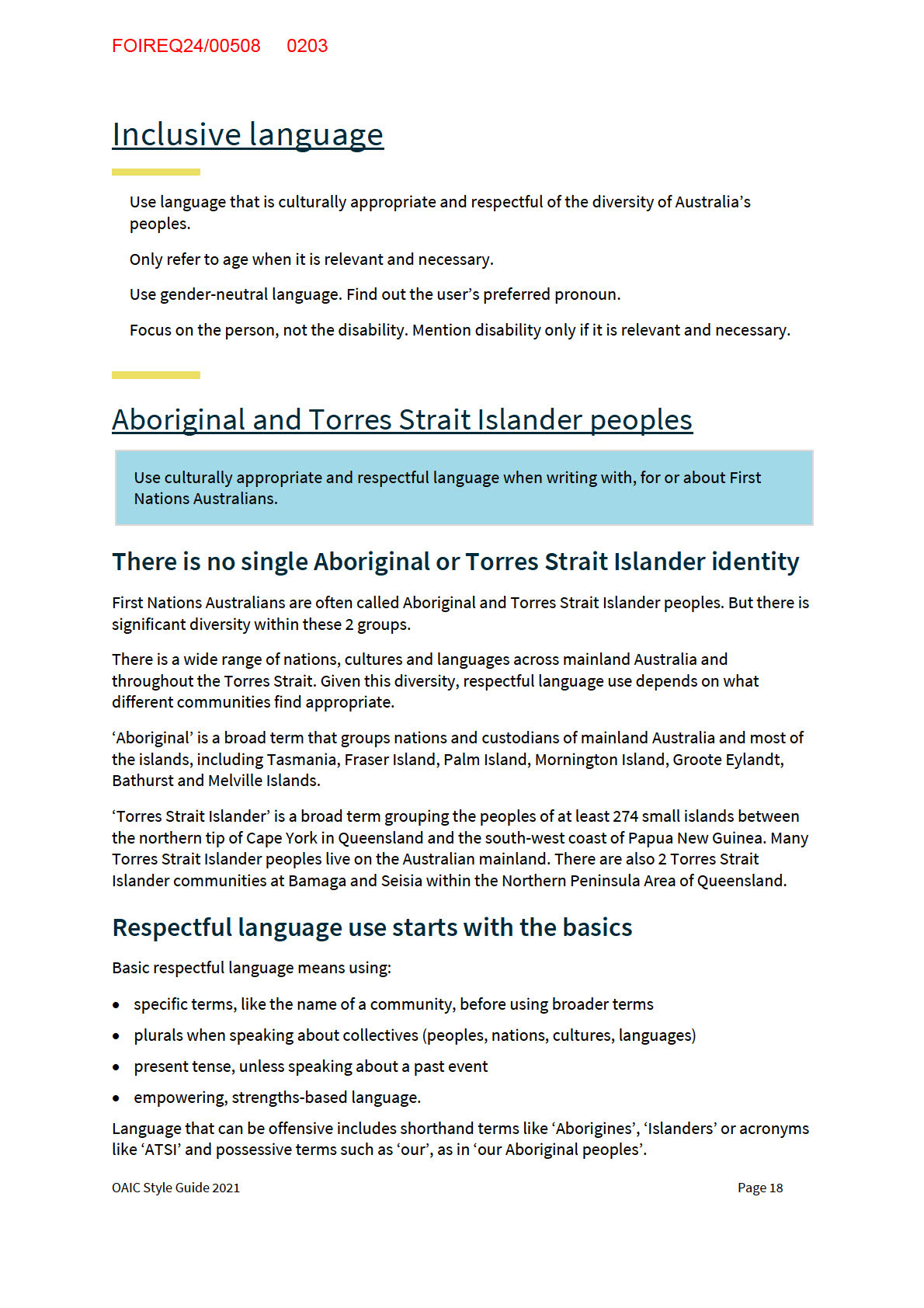
FOIREQ24/00508 0204
The digital Style Manual significantly revises and updates guidance on content that relates
to Aboriginal and Torres Strait Islander peoples.
For example, the sixth edition described the term ‘Indigenous’ as ‘widely acceptable’ as a
subset of the broader term ‘Australian’. The latest, digital edition cautions that use of the
term ‘Indigenous’ can be inaccurate without proper context.
See digital Style Manual: Aboriginal and Torres Strait Islander peoples
Age diversity
Refer to age only if it is necessary. Use respectful language and consistent style if age is
relevant.
If age is relevant, follow style conventions
Question whether age is relevant. Avoid referring to a person’s age or an age group if it’s not
relevant.
If you need to mention age, follow style conventions:
• when the reference to age comes before a noun, punctuate it with hyphens
• unless the age reference begins a sentence, use numerals.
A 39-year-old man faces court today on several charges.
You can withdraw your super once you’re 65, even if you’re still working.
Fourteen-year-old Jasmine Greenwood is the youngest Australian on the Paralympic Games
squad.
Cultural and linguistic diversity
Australians have different cultural backgrounds and speak many languages. Use inclusive
language that respects this diversity.
Speak to the person, not their difference
Use inclusive language. You can use the general term ‘multicultural communities’ to write about
people from different cultural backgrounds.
People writing for government sometimes use the term ‘culturally and linguistically diverse’
(CALD) communities. Avoid using the acronym unless you’re speaking to a specialist audience.
OAIC Style Guide 2021
Page 19
FOIREQ24/00508 0205
Use respectful and inclusive language that talks to the person, not their difference. In
Australia, it’s the law. Commonwealth laws include:
–
Racial Discrimination Act 1975
–
Australian Human Rights Commission Act 1986 –
Public Service Act 1999.
Use the terms ‘given name’ and ‘family name’
Many naming systems around the world differ from those used in English-speaking countries.
Given names come before family names in English-speaking countries. In some Asian cultures,
people write the family name first.
When you ask people their name, don’t ask for ‘Christian name’, ‘first name’, ‘forename’ or
‘surname’. Instead, ask for their:
• given name
• family name.
Gender and sexual diversity
Inclusive language conveys gender equality and is gender-neutral. Respect peoples’
preferences around gender and sexual identity with pronoun choice and job titles.
Use gender-neutral language
Use terms that recognise gender equality. Avoid terms that discriminate on the basis of a person’s
gender or sexual identity.
Our use of language reflects changes in society. There is wide agreement about using language to
support equality between all genders.
It is unlawful to discriminate against a person under the
Sex Discrimination Act 1984. This
discrimination relates to their:
– sex
– marital or relationship status
– actual or potential pregnancy
– sexual orientation
– gender identity
– intersex status.
OAIC Style Guide 2021
Page 20
FOIREQ24/00508 0206
Pronoun choice
Learn the user’s preferred pronoun. If it’s not clear and you can’t ask them, choose gender-neutral
pronouns.
The singular ‘they’ is gender-neutral. It avoids specifying a person’s gender.
You can use ‘they’ or ‘them’ when you would otherwise use a singular personal pronoun such as:
• ‘he’
• ‘she’
• ‘him’
• ‘her’.
You can also use ‘themselves’ or ‘themself’ instead of ‘himself’ or ‘herself’. ‘Themself’ is an
extension of using ‘they’ for a single person.
The use of gender-neutral pronouns to refer to a person of unknown gender has a long history.
Usage now covers people who either:
• don’t wish to identify as a particular gender
• identify as non-binary or gender-fluid.
There are many ways to avoid using gender-specific pronouns.
You must provide copies of the application to your referees. [Use the second-person
pronouns (‘you’ and ‘your’) with direct tone and active voice.]
Candidates must provide copies of the application to their referees. [Use a plural pronoun.
The pronoun ‘their’ relates to a plural subject ‘candidates’.]
Every candidate must provide copies of the application to referees. [Leave the pronoun out
altogether.]
Avoid gender-specific job titles
Avoid using job titles that end in ‘-man’ or ‘-woman’.
Avoid using the traditional terms for jobs that end in ‘-man’ e.g. policeman, foreman.
You should also avoid job terms that specify women e.g. actress, waitress.
The digital Style Manual contains new guidance on inclusive language around gender and
sexual diversity. It adds advice on the distinctions between gender, sex and sexuality, on
LGBTIQ+ communities and on the use of the title ‘Mx’.
See the digital Style Manual: Gender and sexual diversity
OAIC Style Guide 2021
Page 21
FOIREQ24/00508 0207
People with disability
Disability does not define people. Use inclusive language that respects diversity.
Focus on the person, not the disability
Mention disability only when it’s relevant to the content.
When you are writing about people with disability, focus on the person. Use person-first language
for Australian Government content.
people with disability [Person-first language]
disabled person [Identity-first language]
Be responsive if you get feedback on the language you’ve used. It can guide user research around
language that respects individual or community preferences.
Use respectful and inclusive language that talks to the person – not their difference.
Commonwealth laws include:
–
Disability Discrimination Act 1992
–
Australian Human Rights Commission Act 1986
OAIC Style Guide 2021
Page 22
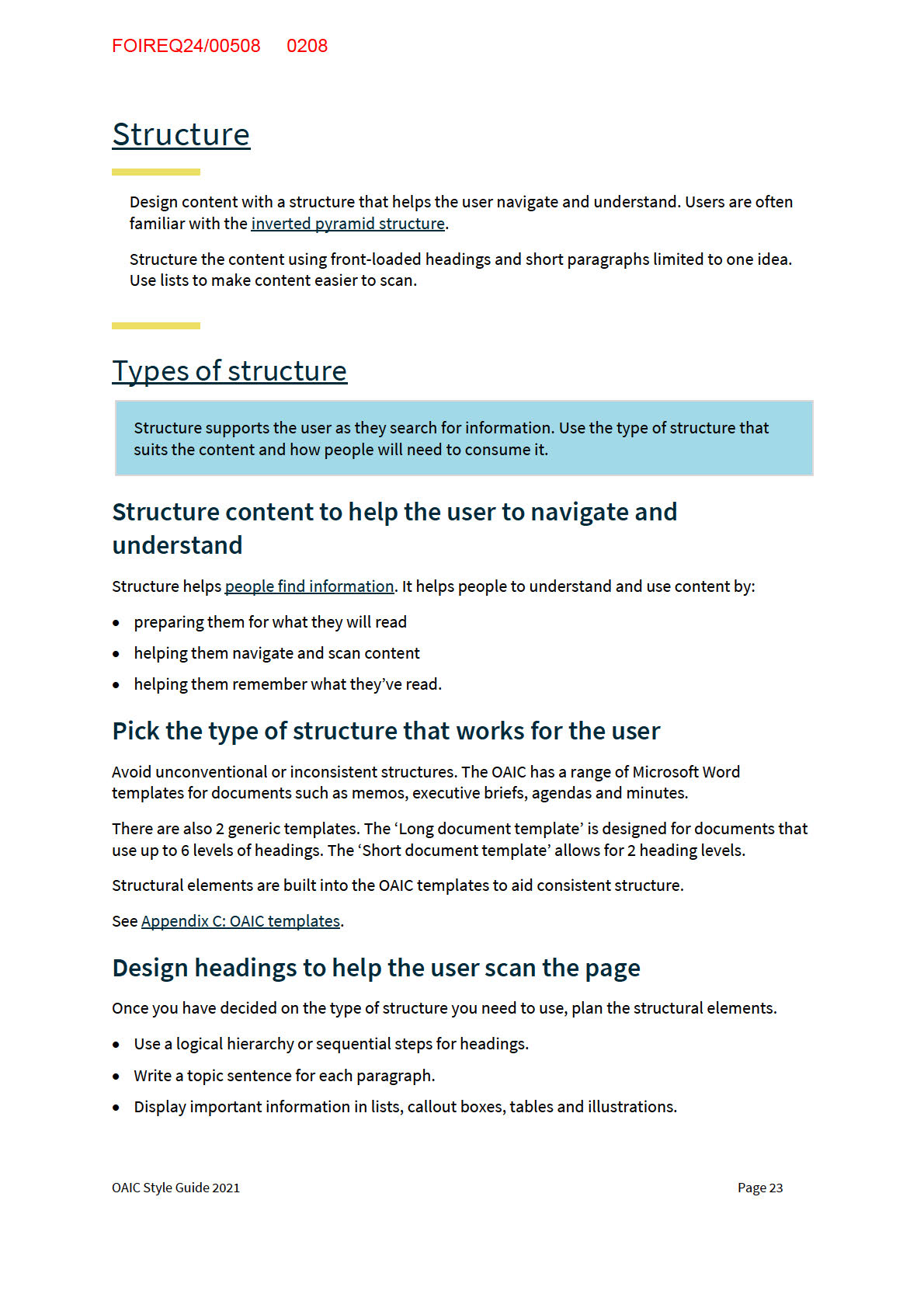
FOIREQ24/00508 0209
Structure your content by writing about one idea at a time. When you write:
• start with the most important idea first
• group related ideas under headings
• organise ideas into short paragraphs.
Headings
Headings help users scan content and find what they need. Organise content using clear
heading levels. Begin each heading with keywords and keep it to the point.
Write headings that are clear and short
Headings organise information. Clear headings are specific to the topic they describe.
Keep them brief. They are signposts for people and for search engines.
Many people skim through headings to check whether a page is relevant before they read it in
detail. Search engines use headings to analyse and rank content.
State the main point
Write headings that tell the user what is in the content below it. Headings should state the main
point. This helps users find content in search results.
Write this
Learn how to drive
Not this
More information
Use fewer than 70 characters
Write headings that are no more than 70 characters (including spaces).
Longer headings are more difficult to read and can be confusing. They might also suggest that you
have too many ideas in a section.
Avoid questions as headings
Starting a heading with ‘why’, ‘how’ or ‘what’ makes it slower for the user to read. They have to
read the whole heading before finding relevant keywords.
OAIC Style Guide 2021
Page 24
FOIREQ24/00508 0210
Use keywords to start headings
Start headings and subheadings with keywords that help people to make a connection.
People scan-read headings to know the relevance of the content. If they use assistive
technologies, they might use the tab key to read from heading to heading. Others who use screen
readers might generate a list of headings for quick navigation.
The keywords should relate to the main content below the heading. Pay special attention to the
first 2 or 3 words. These might be the only words someone reads to decide whether to continue to
scan the page or to read the text.
Using keywords at the start of a heading is called ‘frontloading’. Frontloading makes it easier for
people to assess the heading’s relevance – either on a webpage or in search results. It also helps
search engines find your content.
Be consistent: use a parallel structure
All headings in a level should be consistent.
They should have the same:
• overall message (for example, they are all steps in a process)
• grammatical form (called ‘parallel structure’).
Two common forms are:
• noun phrases (for example, ‘effective headings’ and ‘punctuation and capitalisation’)
• instructions (for example, ‘keep headings short’ and ‘be consistent’).
Write all headings in sentence case and use minimal
punctuation
Use sentence case for headings to help people read the text more easily.
This means you should use a capital letter only for:
• the first letter of the first word
• the first letter of any proper nouns
• letters in acronyms and initialisms.
Don’t use a full stop to end headings
Even if the heading is a sentence, it doesn’t need a full stop at the end.
Avoid using shortened forms in headings
Don’t use a shortened form in a heading unless it is better known than the ful term (for example,
‘DNA’ and ‘CSIRO’).
OAIC Style Guide 2021
Page 25
FOIREQ24/00508 0211
Links
Links can help users navigate content. Include links when they support user journeys. Write
link text that is accurate and accessible.
Link to HTML content by default – only link to a file (e.g. a PDF) if an HTML version is not
available. Always provide the document title, file type and file size (where possible).
Link to HTML content whenever possible
Provide content in HTML format by default. This has benefits for both accessibility and
maintenance. If a full HTML version of the file is not available, link to a summary page if it exists.
When linking to files, include document title, file type and size
There will be some situations in which you need to link to non-HTML documents and files. Give
users the information they need to decide whether to download the file by providing the:
• document title (not the file name)
• the file type
• the file size in kilobytes (kB) or megabytes (MB) (where possible).
Include all this information in the link text, but remember that this adds extra information for all
users. Minimise the number of links where you can.
Write link text that makes the destination clear
Users scan content for links to understand what it is about. People who use assistive technologies
often use the tab key to read from link to link. People who use screen readers often generate a list
of links for quick navigation.
For these reasons, links need to make sense when read out of the context of surrounding content.
Links like ‘click here’ or ‘more information’ don’t give the user any information about the
destination.
Write link text that describes the destination in clear language. Match the content on the linked
page so the user knows they have reached the right place.
Write this
Find out about our upcoming meetings on our
Eventbrite page.
Not this
Click here to find out about our upcoming meetings.
OAIC Style Guide 2021
Page 26
FOIREQ24/00508 0212
Lists
Lists make it easy for users to scan and understand a series of items. Structure and style
lists with the user in mind. Set up grammatical structure for list items with a lead-in.
Structure items in a series as a list
Lists are series of items. All lists have a phrase (lead-in) or heading to introduce the list.
Use lists to:
• help users skim information
• group related information
• help users understand how items relate to each other
• show an order of steps
• arrange information by importance.
Lists can be ordered or numbered (the order is important) or unordered (the order is not critical).
Make short lists
Long lists can lose meaning and hierarchy, as lower items are further away from the lead-in.
Move long lists to a separate page or an appendix.
Limit the number of lists
Content with too many lists is hard to follow. The content should flow so people can read it easily.
Use a consistent pattern for list items
Write items in a list so they follow a consistent pattern. The pattern is made up by the number of
words you use and grammatical structure.
If items follow a consistent pattern, it makes a list easier to scan and understand.
Write list items so they have parallel structure
Write all list items so they have the same grammatical structure. This is called ‘parallel structure’.
It makes lists easier to read. To make a parallel structure, use the same:
• word type to start each item (such as a noun or a verb)
• tense for each item (past, present or future)
• sentence type (such as a question, direction or statement).
Move any words repeated in the list items to the lead-in.
OAIC Style Guide 2021
Page 27
FOIREQ24/00508 0213
Write this
Not this
I will:
I will be:
read more emails
reading more emails
go to meetings
going to meetings
be punctual.
punctual
[The last item is an adjective while other list items begin with verbs.]
Punctuate lists according to style
Unnecessary punctuation makes your list look cluttered. Current government style is for minimal
punctuation.
Use minimal punctuation for all lists
In a bullet or numbered list, don’t use:
• semicolons or commas at the end of list items
• ‘and’ or ‘or’ after list items.
Only include ‘and’ or ‘or’ after the second-last list item if it is critical to meaning – for example, you
are writing in a legal context. Make sure the lead-in is a clear guide for how this kind of list should
be interpreted.
Lead-ins for incomplete lists can use ‘for example’, ‘including’ or ‘includes’.
Don’t write ‘etc.’ at the end of the list to show the list is incomplete.
When listing items that may be additional or optional, write a lead-in to explain any variables.
Use full stops to complete sentences and fragment lists
Sentence lists and fragment lists are 2 types of list that use full stops.
• Finish each item in a sentence list with a full stop, including the last one.
• Finish fragment lists with a full stop only after the last item.
If you don’t include the full stop, people using screen readers may assume the next paragraph is
part of the list.
A stand-alone list is a third type of list. If you are not breaking up a paragraph or a sentence,
consider a stand-alone list. Stand-alone lists use a heading, not a lead-in. Start each item
with a capital letter. Don’t add full stops to the end of any items (even the last item).
OAIC Style Guide 2021
Page 28
FOIREQ24/00508 0214
Avoid using a multilevel list
Multilevel lists group information into a hierarchy. The levels explain how each item relates to
other list items.
If you have to use multilevel lists:
• don’t use more than 2 levels
• use lowercase letters for the second level in a numbered list
• use a dash for the second level in a bullet list, not hollow (open) bullets
• use the same symbol, number or letter for the same level in each list.
Paragraphs
One idea per paragraph helps users absorb information. Organise them under headings to
help users scan the content. Write short paragraphs, each with a topic sentence.
Limit each paragraph to one idea
People find it easier to understand content when a paragraph contains only one idea or theme.
Don’t introduce a new idea in the middle or at the end of a paragraph. Start a new paragraph
instead.
Introduction or summary paragraphs recap ideas covered in the content. Group sentences in these
paragraphs by theme – for example, to help users understand how the content is structured.
Keep most paragraphs to 2 or 3 sentences
Short paragraphs help people understand content. The ideal length depends on what you are
writing.
• Media releases and news articles have only one or 2 sentences in a paragraph.
• Content designed for mobile screens has no more than 2 or 3 sentences in a paragraph.
• In reports and other long-form content, a limit of 6 sentences in a paragraph is acceptable.
If your paragraphs or sentences are too long, you might be trying to say too much in one place.
Consider starting a new paragraph or using an itemised list. Make sure the items relate to each
other and are grammatically parallel.
OAIC Style Guide 2021
Page 29
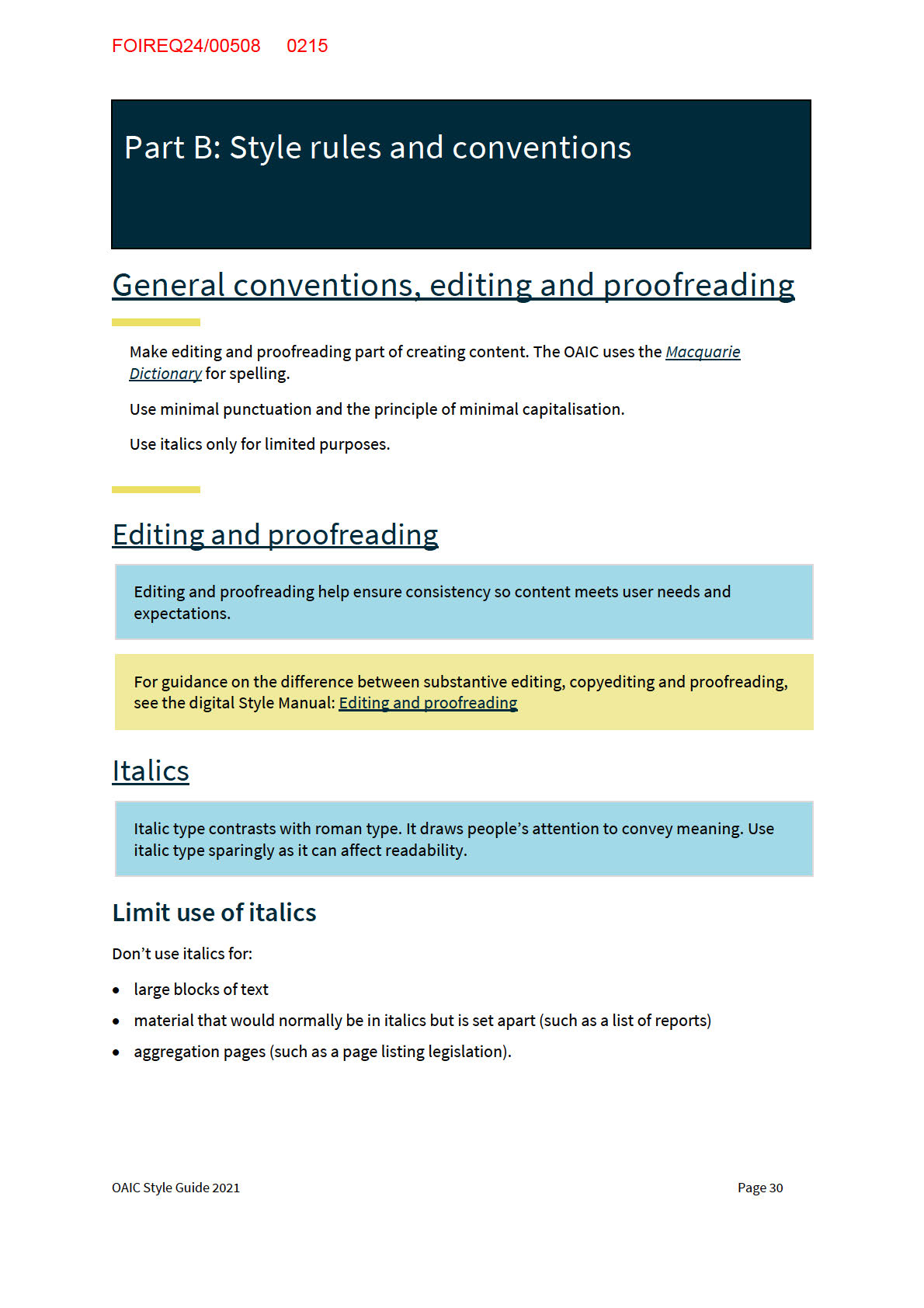
FOIREQ24/00508 0216
Italicise titles of stand-alone works, legal cases and Acts
A title or name in italic type shows that it is formal and complete. Shortened versions of the title
and common titles are in roman type. Follow the detailed Style Manual guidance for referencing
and attribution.
Published works
Use italics for the titles of these published works:
• books and periodicals
• plays
• classics
• most musical compositions
• ballets and operas
• films, videos and podcasts
• blogs
• television and radio programs
• artworks.
Unpublished works are in roman type.
Full titles of Acts and legal cases
Use italics for primary legislation and legal cases but not for delegated legislation or bills.
See Legal material
Set off most foreign words and phrases
Italics contrast words and phrases that are not in English from surrounding text. Foreign words
and phrases should generally be avoided in government writing, unless there is no English
equivalent.
Standard Australian English can absorb words or phrases from other languages. Write these
‘borrowed’ words without italics or accent marks.
Stress words with special emphasis, but rarely
Sometimes you want to stress a word for meaning or to convey emotion, including a change in
tone. Italics, used sparingly, can work for this purpose.
Don’t use italics when another style or formatting option is available. Single quotation marks can
work for emphasis unless they’re serving a different stylistic use.
OAIC Style Guide 2021
Page 31
FOIREQ24/00508 0217
Emphasis in quotations
Sometimes, you might want to add italics to quotations to bring attention to particular words or
phrases. If you do this, write ‘emphasis added’ in square brackets following the italicised text.
Punctuation and capitalisation
Punctuation and capitalisation have rules for correct use. Use minimal punctuation and
capitalisation to make content more readable.
Include a single space after a full stop. Never use double spaces.
Use minimal punctuation to make meaning clear
Minimal punctuation doesn’t mean removing all punctuation marks from a sentence. It means
removing unnecessary punctuation.
Only use punctuation that makes the sentence grammatically correct and the meaning clear.
Too much punctuation makes text crowded and difficult to read. If a sentence has a lot of
punctuation marks, it might be a sign that the sentence is too long or complex. Try to rewrite into
shorter, clearer sentences.
To use minimal punctuation:
• don’t add full stops to the ends of headings, page headers, footers or captions
• don’t use a semicolon at the end of each item in a bullet list
• unless each item is a full sentence or the last item in a list, don’t use a full stop for items in
bullet lists
• don’t use full stops between letters in an acronym or initialism
• don’t use a full stop at the end of most abbreviations.
Minimal punctuation helps all users to understand content.
Use the correct spacing around punctuation marks
There are different rules for putting spaces around punctuation marks. For example, some
punctuation marks have no spaces around them. Some have a space on either side.
Include a single space after a punctuation mark at the end of a sentence (full stop, exclamation
mark or question mark).
Never use double spaces. Check each document for double and multiple spaces and delete them.
Minimise capitals for common nouns and adjectives
Proper nouns generally have an initial capital letter for each word in the noun.
OAIC Style Guide 2021
Page 32
FOIREQ24/00508 0218
Common nouns and adjectives don’t use initial capitals, with few exceptions. For example,
adjectives often have capitals when they refer to a national, religious or linguistic group.
Follow the guidance on capitals for titles and government
terms
Follow the conventions for using capitals in this Style Guide.
See Titles, honours, forms of address
See Government terms
Spelling
Spelling errors detract from readability. Follow one dictionary for consistency and to check
variable spellings.
Macquarie Dictionary
The OAIC follows
Macquarie Dictionary spelling.
You should be automatically logged into the
Macquarie Dictionary when you are working in
the office.
To log in at home go to macquariedictionary.com.au and enter the following:
Username:
OAIC
Password:
OAIC1234
The Australian Government standard is to use Australian English spelling and not American
spelling. The only time you should use a ‘z’ instead of an ‘s’ is for a proper noun e.g. World Health
Organization.
The exception to this rule is quoted material, when you should use the spelling in the published
original.
Australian English in Microsoft Word
To prevent Microsoft Word from Americanising your spelling and converting ‘s’ to ‘z’ go to
the Review tab, click on Language and then Set Proofing Language. Select English
(Australia) and click on Set As Default. OAIC templates are set to default to Australian
English spelling. See Appendix C: OAIC templates.
OAIC Style Guide 2021
Page 33
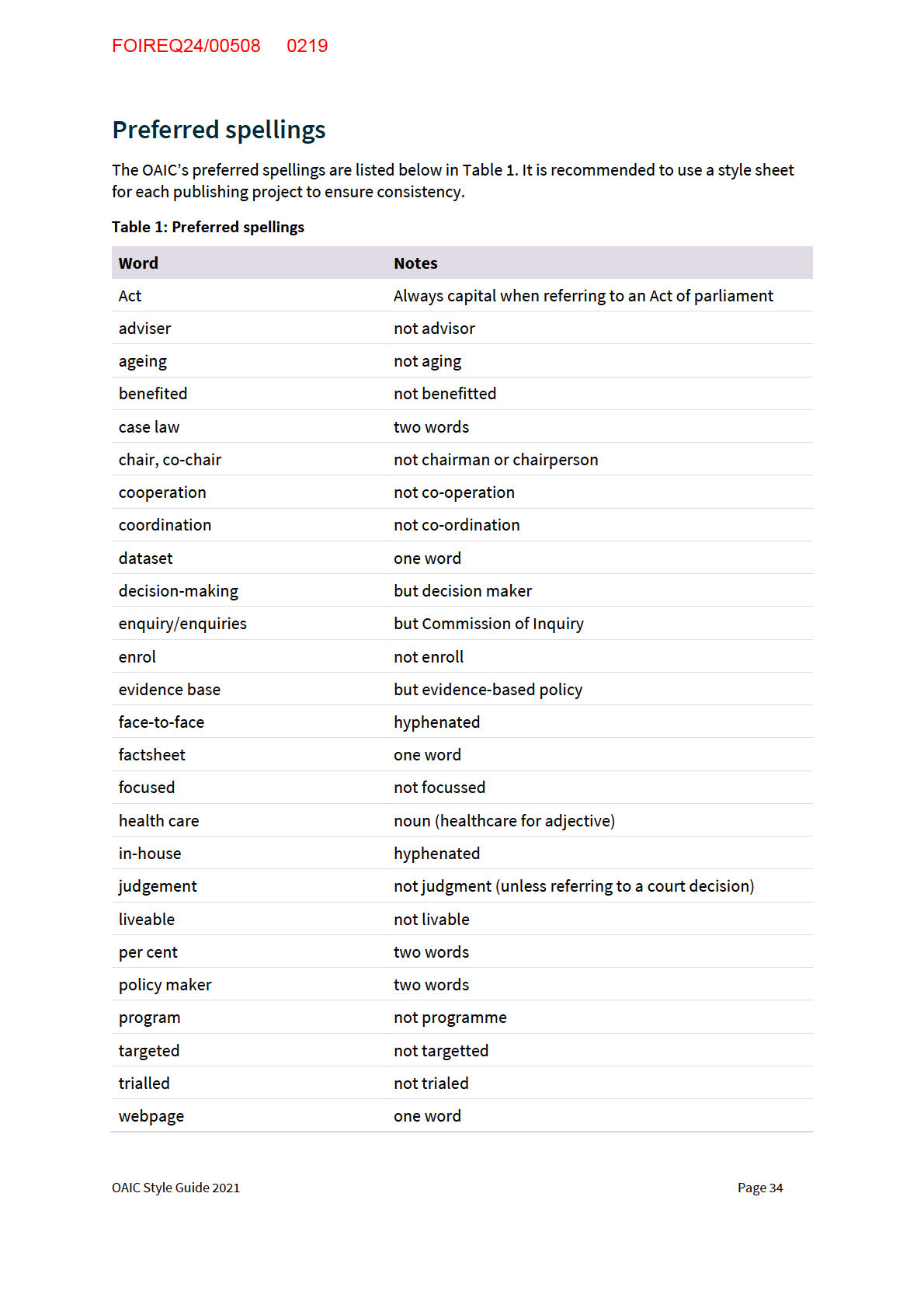
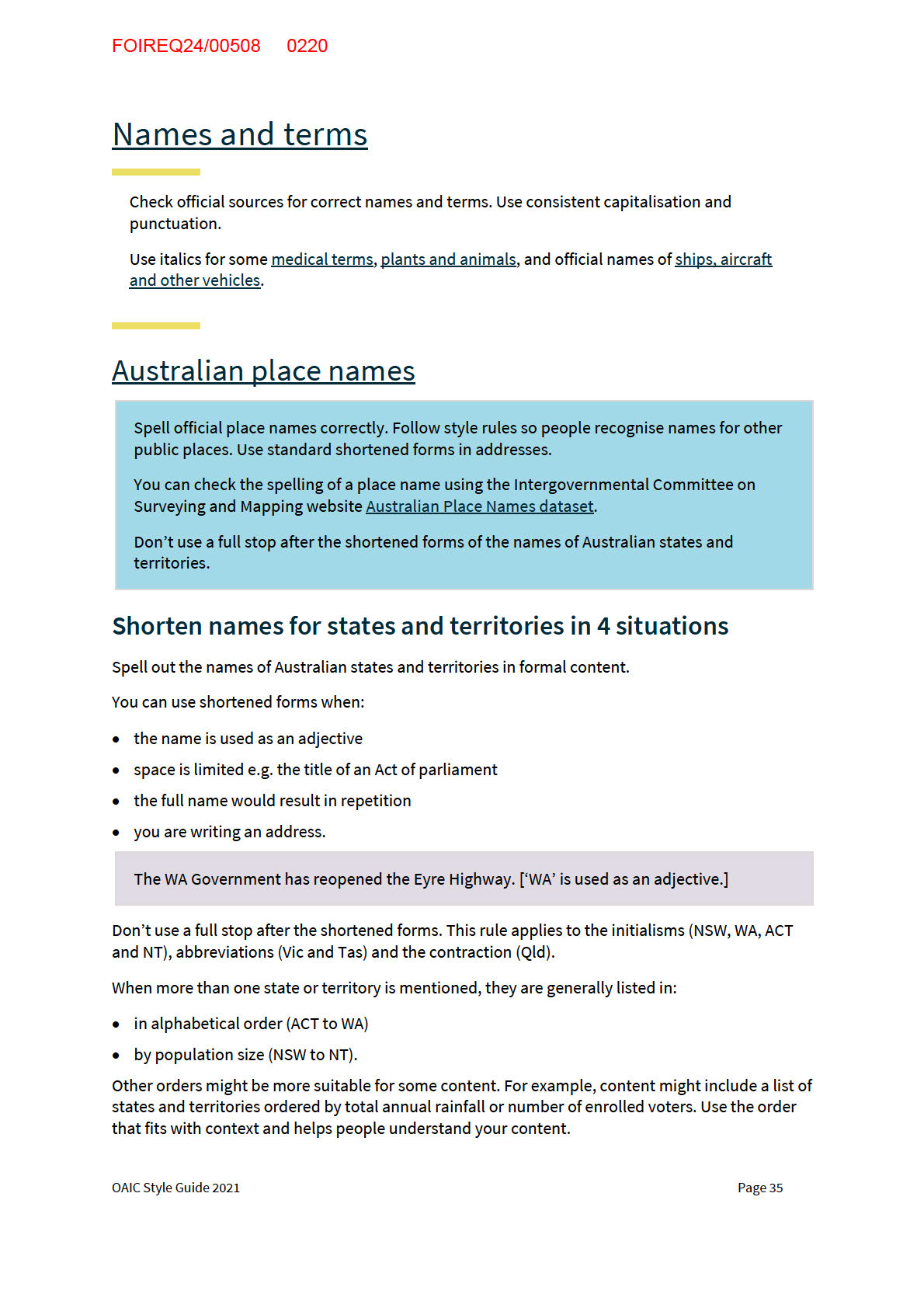
FOIREQ24/00508 0221
Shortened names for states and territories (by population size)
NSW
Vic
Qld
WA
SA
Tas
ACT
NT
Government terms
Use the correct term and follow the rules for capitalising government terms. People find it
easier to understand content that has a consistent style.
Use initial capitals for formal names and titles
Use initial capitals only for the formal names and titles of government entities and office holders.
Use lower case for generic references.
There are some exceptions to this rule:
• Budget (unless you are using it as an adjective or as a plural)
• Cabinet
• Commonwealth
• Crown
• Treasury.
Australian Government
Refer to the national government of Australia as the ‘Australian Government’. Use an initial capital
for both words only when they occur together.
Always use Australian Government. Do not use Commonwealth Government or Federal
Government.
Departments and agencies
Use initial capital letters only for the formal names of government departments and agencies.
Check the names of departments and agencies in the government online directory.
OAIC Style Guide 2021
Page 36
FOIREQ24/00508 0222
Don’t use capital letters for generic mentions. For example, use:
• ‘the agency’ instead of ‘the Agency’
• ‘the commission’ instead of ‘the Commission’
• ‘the department’ instead of ‘the Department’.
Use a shortened form of the name only if the department or agency uses it regularly in their own
content.
If you cite a source written by an organisation that has since changed its name, use the name
published in the source. This might not be the organisation’s current name.
The Flipchart of Commonwealth entities and companies (PDF) is a handy 2-page reference
guide, organised by portfolio, that lists departments and agencies with links to the relevant
websites.
The List of Commonwealth entities and companies (PDF) is a 30-page document, organised
by portfolio, which provides ABNs, enabling legislation and other governance-related
details for departments and agencies, as well as links.
The Department of Finance produces the flipchart and list and the dates reflect when the
documents were updated, not when the change occurred.
More information about government bodies can be found at Types of Australian
Government bodies and Australian Government Organisations Register.
Government programs and agreements
Use initial capitals for the full names of:
• government programs
• treaties
• protocols and similar agreements.
National Aged Care Advocacy Program
Legislation
Use initial capitals for these terms when referring to specific legislation:
• Act
• Ordinance
• Regulation
• Bill.
Use lower case for generic references to bills, regulations and ordinances.
OAIC Style Guide 2021
Page 37
FOIREQ24/00508 0223
Use initial capitals for all references to Acts.
Use government sources to check the titles of legislation, especially:
– the Federal Register of Legislation
– the Australian Parliament House list of bills and legislation.
See Legal material
See Delegated legislation
Commercial terms
Brands and model names are protected by law. Unless using common names, write trade
mark names and use symbols so people can understand legal status.
For guidance see the digital Style Manual:
Use initial capitals for commercial terms
Use a common word for a product if you can
Take care using product names
Dates and time
Dates and times need to be readable. Write, abbreviate and punctuate dates and times
consistently so people can understand your content.
Follow Australian conventions for dates
Australian style conventions apply to dates expressed in numerals and words, and in numeric
formats.
Months and days
Months and days are proper nouns, so they start with an initial capital.
Use abbreviations only if space is limited, for example, in tables, illustrations, charts and notes.
Ensure it is obvious to users which months or days you are referring to.
OAIC Style Guide 2021
Page 38
FOIREQ24/00508 0224
The standard abbreviations for the days of the week are:
Monday – ‘Mon’ or ‘M’
Tuesday – ‘Tues’ or ‘Tu’
Wednesday – ‘Wed’ or ‘W’
Thursday – 'Thurs’ or ‘Th’
Friday – ‘Fri’ or ‘F’
Saturday – ‘Sat’ or ‘Sa’
Sunday – ‘Sun’ or ‘Su’.
The standard abbreviations for the months are:
January – ‘Jan’
February – ‘Feb’
March – ‘Mar’
April – ‘Apr’
May – retain as ‘May’
June – retain as ‘June’ or shorten to ‘Jun’
July – retain as ‘July’ or shorten to ‘Jul’
August – ‘Aug’
September – ‘Sept’
October – ‘Oct’
November – ‘Nov’
December – ‘Dec’.
Full dates
In general, use numerals for the day and the year but spell out the month in words. Don’t include a
comma or any other punctuation. When using full dates, don’t use ordinal numbers.
Write this
Friday 1 May 1997
Not this
May 1, 1997
Friday, 1 May 1997
1st May 1997
Use ‘from’ and ‘to’ in spans of years
Avoid en dashes in spans of years. Write the years out in full.
OAIC Style Guide 2021
Page 39
FOIREQ24/00508 0225
from 2015 to 2019
The exceptions are:
• financial years
• information in parentheses, such as terms of office and years of birth and death.
For these, use an en dash without any spaces on either side.
the 2020–21 financial year
Sidney Nolan (1917–1992) had 3 younger siblings.
Don’t use an apostrophe for decades
Write the span of decades with an ‘s’ on the end. Do not use an apostrophe.
2010s not 2010’s
1980s not 1980’s
Use numbers for the time of day when you need to be precise
In most documents, especially when you need to be precise, numbers give a clearer expression of
time.
Use a colon between the hours and minutes. The use of a colon as the separator reflects a shift in
contemporary Australian usage and avoids confusion with decimal numbers.
The bus leaves at 8:22am.
Write ‘o’clock’ only when quoting someone directly or transcribing a recording. Use numerals and
the word ‘o’clock’.
‘The minister is speaking at about 10 o’clock,’ they said.
Times using ‘am’ and ‘pm’
Use ‘am’ and ‘pm’ in lower case. You can use 2 zeros to show the full hour, but they aren’t
essential.
9am or 9:00am
OAIC Style Guide 2021
Page 40
FOIREQ24/00508 0226
Noon, midday and midnight
Use ‘noon’, ‘midday’ or ‘midnight’ instead of ‘12am’ or ‘12pm’ to make it easier for people using
your content to be certain of the time.
Time zones
You might also need to define which time zone you are referring to.
The Australian zones are:
CST (Central Standard Time)
CDT (Central Daylight-saving Time)
EST (Eastern Standard Time)
EDT (Eastern Daylight-saving Time)
WST (Western Standard Time).
We generally add an ‘A’ (to represent ‘Australian’) to the front to avoid confusion.
10:30am AEST
Organisation names
Spell and punctuate organisation names correctly. This helps people to understand your
content.
Write the name as the organisation writes it
Organisations determine how their names should be spelt and punctuated. This does not always
follow the usual rules.
Write the name of the organisation the same way the organisation writes it. This rule applies
except in rare cases when the organisation name is in all lower case. Use an initial capital for these
names in general text. This helps people identify the name as a proper noun.
Some names start with a lower case letter but have a medial capital (for example, ‘eBay’). Write
the name the same way, including to begin a sentence. A medial capital is enough to identify the
name as a proper noun.
eSafety keeps tips on its website topical and up to date.
OAIC Style Guide 2021
Page 41
FOIREQ24/00508 0227
Pay attention to the use of capital letters, punctuation (such as apostrophes) and logograms (such
as ‘&’). Make sure to include all words in the name. Don’t add additional words.
United Nations Educational, Scientific and Cultural Organization [Note the lack of
apostrophe for ‘Nations’ and the variant spelling of ‘Organization’.]
Department of the Prime Minister and Cabinet (PM&C) [The ampersand is part of the
initialism but not the spelt-out form.]
State Library Victoria [The name is not the ‘State Library of Victoria’. It does not include a
preposition.]
Meat & Livestock Australia [The ampersand is part of the name.]
Check the correct name of an organisation
The names of organisations can change. The most efficient way to confirm an organisation’s name
is to check its website, annual report or letterhead.
• For Australian Government entities, use the government online directory. It includes the
Australian Government organisations register and the directories of state and territory
governments. There are also website directories for some local governments.
• Name searches are useful for company and business names, especially the ABN
lookup, Australian Securities and Investments Commission registers and the Australian
Securities Exchange’s listed companies.
If you cite a source written by an organisation that has since changed its name, use the name that
was published in the source. This may be the organisation’s past name.
Before September 2013, the Department of Social Services was called the ‘Department of
Families, Housing, Community Services and Indigenous Affairs’.
Shortened forms of the name
Use the organisation’s shortened form only if the organisation regularly uses it in its own content.
For example, the Department of Home Affairs uses ‘Home Affairs’ as the shortened form. It would
be inappropriate to use ‘DHA’ to refer to Home Affairs. However, Defence Housing Australia does
use the initialism ‘DHA’, so using it to refer to that organisation would be appropriate.
Spell out the shortened form the first time, unless the organisation’s name is known only by the
shortened form.
OAIC Style Guide 2021
Page 42
FOIREQ24/00508 0228
In general text, use lower case for the definite article in the names of
organisations
Some organisations use the definite article ‘The’ in their name with an initial capital. Use the full
name, including ‘The’, in 2 situations:
• letters
• if the name appears in an alphabetical list (arrange by ‘The’ as the first word in the name)
Always use lower case ‘the’ in general text. This follows the practice of most organisations.
The University of Sydney [Correct name, not ‘University of Sydney’]
Next year the University of Sydney will renovate its science buildings. [General text uses
lower case for ‘the’]
Put a possessive apostrophe in a name if the organisation
does
Use an apostrophe only when it forms part of the official name of an organisation.
Actors’ and Entertainers’ Benevolent Fund Qld
In all other cases for organisation names, don’t use possessive apostrophes.
The apostrophe is disappearing from many organisational names, particularly from those that
contain plural nouns ending in ‘s’. In these cases, the plural noun is descriptive rather than
possessive.
Australian Securities and Investments Commission
Minerals Council of Australia
Australian Workers Union
We do not use possessive apostrophes for the names of our OAIC networks.
Information Contact Officers Network (Officers is descriptive)
Privacy Professionals Network (Professionals is descriptive)
Use the singular verb with organisation names
In formal writing we use a singular verb with organisation names. On our website and in social
media, ‘they’ is acceptable for an organisation or agency.
OAIC Style Guide 2021
Page 43
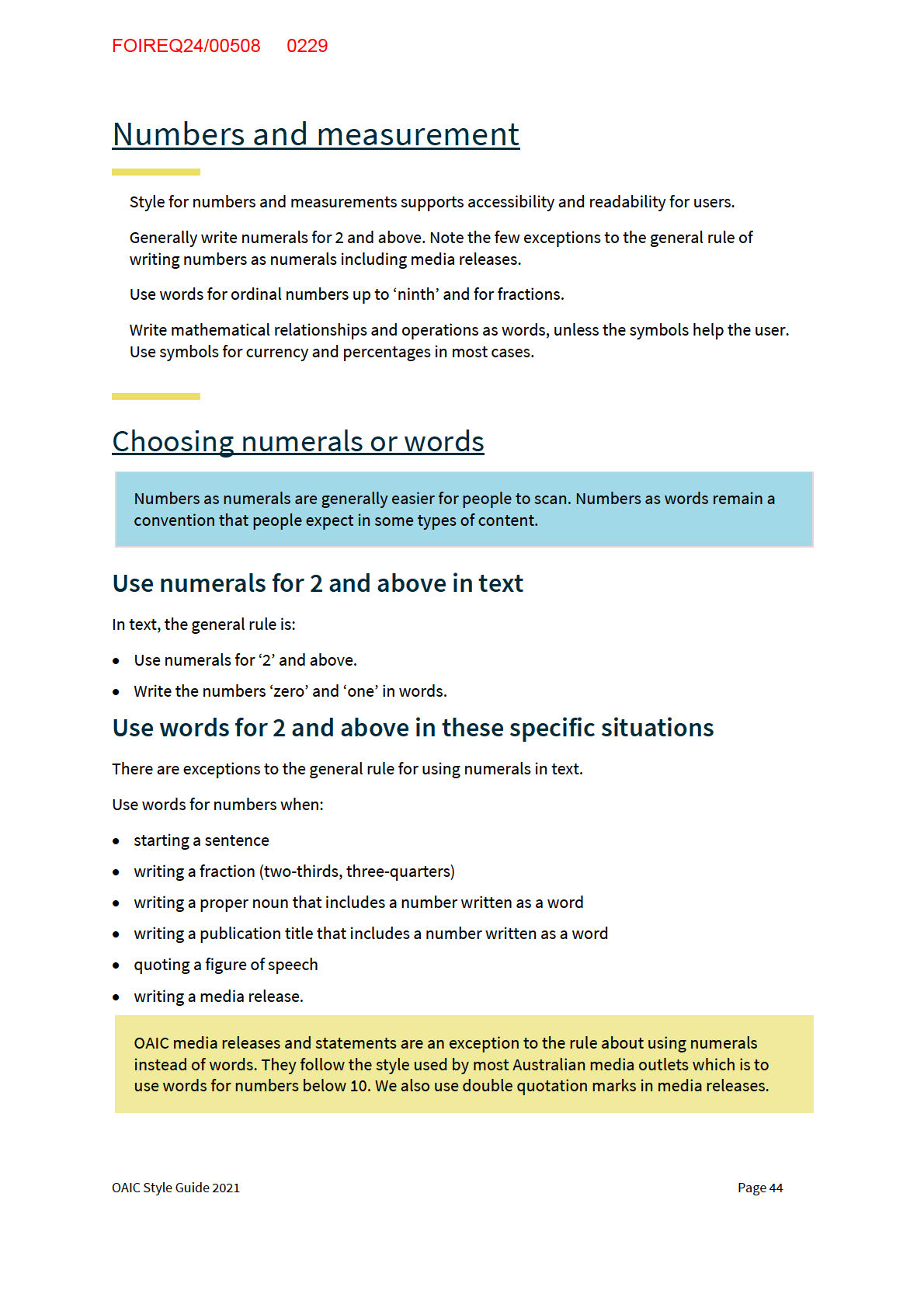
FOIREQ24/00508 0230
Write all numbers as numerals in these specific situations
There are exceptions to using words for ‘zero’ and ‘one’.
Write all numbers as numerals:
• in units of measurement
• to show mathematical relationships – such as equations and ratios – and for decimals
• when you are comparing numbers
• in tables and charts
• for dates and times
• in a series of numbers
• in specific contexts – such as steps, instructions, age and school years
• in scientific content.
Date and times
Always use numerals for date and times. Use a colon between the hours and minutes.
Series of numbers
In any document that contains a lot of numbers, it is always better to write numbers as numerals.
Always use numerals for:
• a related group of items
• a discussion of statistics.
This is regardless of the size of the numbers involved.
The anthology includes 160 poems by 22 poets – 14 of whom were born in Australia, 4 in
New Zealand, 3 in England and 1 in Austria.
If you have 2 series of numbers, for the sake of clarity you can use words for one series and
numerals for the other.
Of the mothers of the 23 sets of triplets registered during the year, 8 had no previous
children, 8 had one child and 7 had two previous children.
Choose between numerals or words for currency
Use numerals and symbols for amounts of money.
However, money can be written entirely in words for approximations and figures of speech.
OAIC Style Guide 2021
Page 45
FOIREQ24/00508 0231
Combine numerals and words for large rounded numbers
Numbers up to one million are easy to read as numerals. When you’re using rounded numbers of
1,000 or more, use commas to separate numerals into groups of 3 (working right to left).
Use a combination of numerals and words for large numbers over a million when they are
rounded. It is easier to read ‘2.5 million’ than ‘2,500,000’.
The budget allocated $50 billion to that initiative.
The organisation announced $3 trillion in superannuation savings.
Currency
Use the correct numbers, words and symbols for currency so people are clear about the
amount.
For guidance see the digital Style Manual:
Quantify an amount of money with a symbol and numeral
Clarify when you are using Australian dollars
Reference non-Australian currencies for accessibility
Quantify large amounts of money
Use words for inexact amounts
Measurements and units
Standard units of measurement support readability and accuracy. Express precise values
for users by combining numerals with the correct unit symbol.
For guidance see the digital Style Manual:
Use the standard units of measurement
Write numerals with units of measurement
Use symbols for common units of measurement
Put a non-breaking space between numbers and units
Don’t add ‘s’ for plural forms
Compare measurements using the same units
Only use non-SI units if the user understands them
Avoid imperial units
OAIC Style Guide 2021
Page 46
FOIREQ24/00508 0232
Ordinal numbers
Ordinal numbers such as first, second and third show the order and importance of things.
With large ordinals, spell out the number and include the suffix, for example, the millionth
visitor.
Avoid using ordinals to order points in general text. Reword the content or use a numbered
list instead. A list is easier for people to follow.
Exclude ordinals in dates, use plain numerals, for example, 12 February 2005.
Sort and compare the order of things using ordinals
Ordinal numbers show the order or position of something in a sequence.
Ordinals always have a suffix:
‘-st’ (‘first’, ‘21st’)
‘-nd’ (‘second’, ‘32nd’)
‘-rd’ (‘third’, ‘103rd’)
‘-th’ (‘fourth’, ‘15th’, ‘55th’ and so on).
Ordinal numbers to ‘ninth’
Write ordinal numbers up to ‘ninth’ in words.
the third example
the 11th hour of the 11th day of the 11th month
Percentages
Percentages help people compare things and understand proportions. Use numerals with
the percentage sign. Be concise when you write about percentages.
Use numerals with the percentage sign
Use the percentage sign next to a numeral in text. Don’t use a space between the number and the
percentage sign.
OAIC Style Guide 2021
Page 47
FOIREQ24/00508 0233
15%
Use decimals rather than fractions with the percentage sign.
Write
The price of Tapis oil is up by 0.25%.
Not
The price of Tapis oil is up by ¼%.
Avoid starting a sentence with the percentage. Reword the sentence if possible, or write the
percentage out in words. You can use everyday words if a precise amount is not needed.
Use the correct form of the noun (percentage)
‘Per cent’ and ‘percentage’ aren’t the same. The term ‘per cent’ is an adverb. The noun form is
‘percentage’.
Statistics show the percentage of Australians with university degrees is increasing.
‘Per cent’ is written as 2 words in Australia. ‘Percent’ is not Australian spelling.
Don’t use percentages to describe change
Avoid using percentages to describe changes.
Tell people what the actual increase or decrease is.
Like this
The application fee is now $70. This is a $20 increase from 1 January 2020.
Not this
The application fee increased by 40% from $50 to $70 on 1 January 2020.
Be concise when writing about percentages
When you use many percentages in running text, put the figures in brackets (parentheses) or use a
list to simplify the text.
In 2019, population size increased in New South Wales (32%), Queensland (20%) and
Victoria (19%).
OAIC Style Guide 2021
Page 48
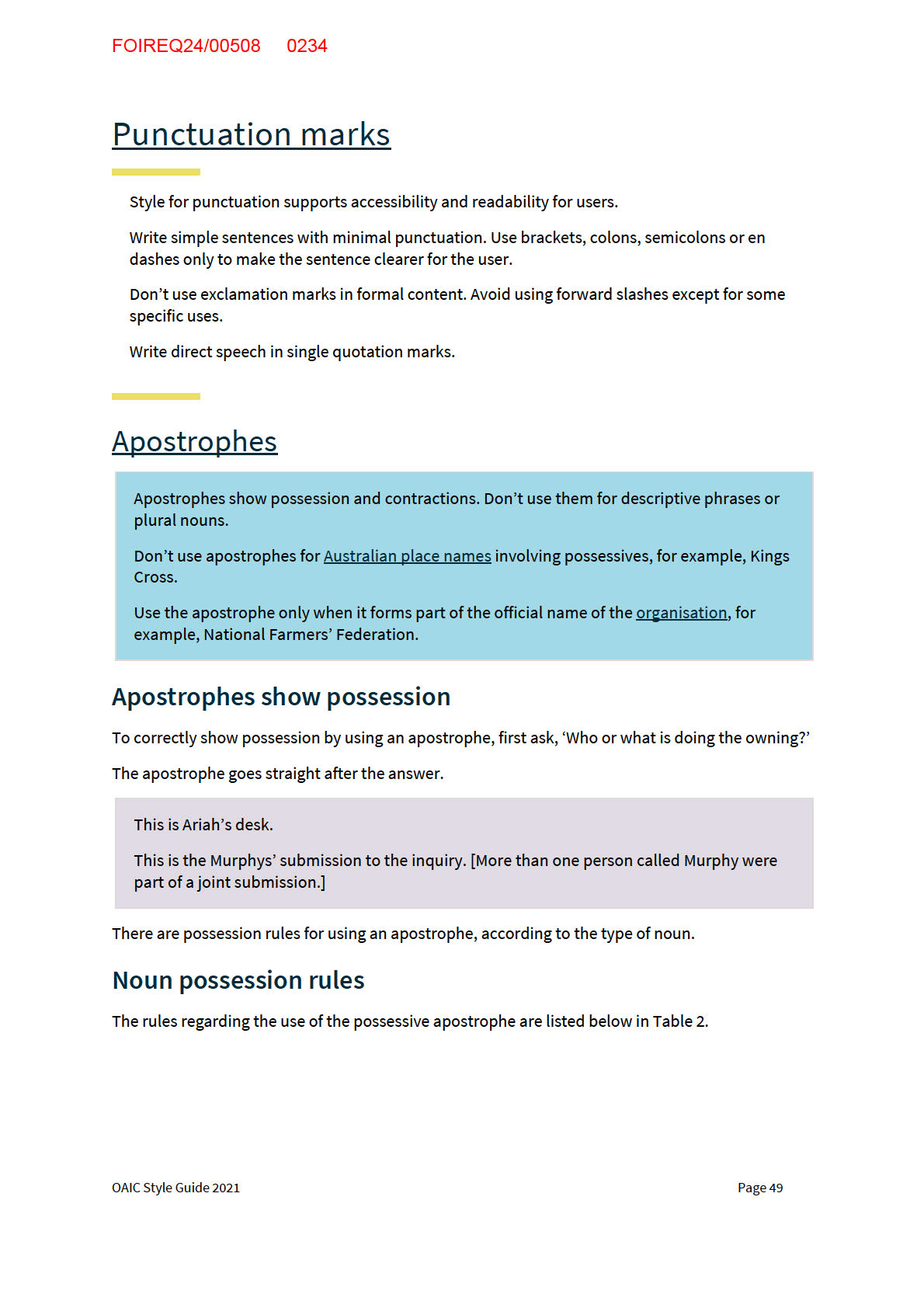
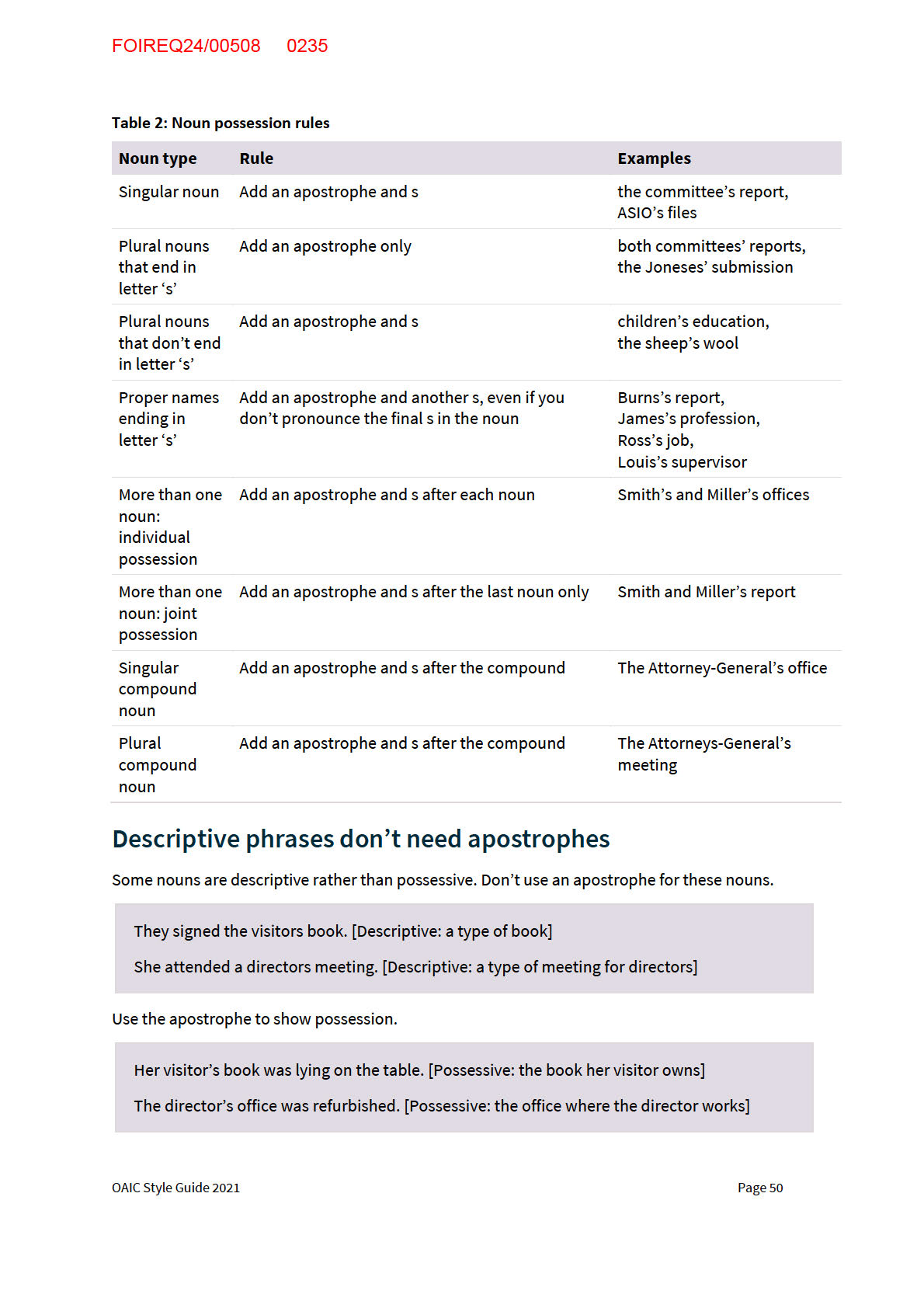
FOIREQ24/00508 0236
Noun phrases about time don’t need apostrophes because they’re descriptive, not possessive.
6 weeks time
3 months wages
When the time reference is in the singular, use an apostrophe to show the noun is singular.
a day’s work
the year’s cycle
Apostrophes show contractions
Apostrophes show that you have omitted letters in contractions.
I haven’t seen the report.
It’s a busy day at the office.
Don’t confuse ‘it’s’ (the contraction of ‘it is’ or ‘it has’) with ‘its’ (to show that ‘it’ owns
something).
If you can divide ‘it’s’ into ‘it is’ or ‘it has’, then you need to use an apostrophe. ‘Its’ is a
possessive pronoun and doesn’t have an apostrophe.
It’s time to give the committee its terms of reference.
Plural nouns don’t have apostrophes
No apostrophe is needed for the plural form of a noun. This type of error is known as the
‘greengrocer’s apostrophe’.
25 million Australians
the 2020s
committee reports
fresh avocados
OAIC Style Guide 2021
Page 51
FOIREQ24/00508 0237
Brackets and parentheses
Brackets can make it easier for the user to scan text. Use brackets when it would not change
the meaning if you removed enclosed text.
Avoid using square brackets inside parentheses.
Don’t use sets of parentheses inside each other. Instead, use square brackets if you must
put parenthetical information within parentheses.
Use square brackets to show insertions in quotes.
Use brackets for text users can skip over
Brackets can help you break up information. They enclose parts of the sentence that aren’t
essential to the meaning. Sentences must be grammatically correct if you remove the text in
brackets.
The most commonly used brackets are:
• parentheses
• square brackets.
Use brackets sparingly for:
• non-essential information
• shortened forms
• references
• insertions.
Use brackets only where they make content clearer to people. For example, always use brackets in
author–date citations.
Too many brackets, or badly used brackets, can make a sentence more complex and difficult to
understand. You can usually rewrite a sentence so the content in brackets can be its own sentence
or can even be removed.
Put extra information in parentheses
Information in parentheses is less important than information that is between spaced en dashes
or pairs of commas. Used well, parentheses can improve meaning and make content easy to scan.
Definitions
Parentheses enclose definitions.
OAIC Style Guide 2021
Page 52
FOIREQ24/00508 0238
Medicare (Australia’s universal health insurance scheme) guarantees all Australians access
to a wide range of health and hospital services.
Shortened forms
Parentheses introduce a shortened form after it has been spelt out in full. You can then use the
shortened form through the rest of the page or publication.
The National Health and Medical Research Council (NHMRC) is responsible for research
funding and health guidelines.
Cross-references
Parentheses enclose cross-references to other parts of the content.
Australia’s population increased by 350,000 people last year (Table 1).
Citations
Parentheses enclose citations in the author–date system of referencing.
China is Australia’s largest trading partner (Smith 2019).
Extra detail
Parentheses enclose extra detail.
Our 2 biggest exports are iron ore ($61.4 billion) and coal ($60.4 billion).
The winning tenderer (which was a local company) signed the contract on Tuesday.
Clarification and asides
Parentheses enclose text that doesn’t have a grammatical relationship to the rest of the sentence.
This type of text includes extra information, clarifications and asides.
The department was in a heritage-listed building. (The building was designed by award-
winning architect Enrico Taglietti.)
Whitlam’s comments on the steps of Parliament House (‘Well may we say .. ’) are still widely
quoted.
OAIC Style Guide 2021
Page 53
FOIREQ24/00508 0239
Write brackets in the same type as the surrounding text
Brackets should be in the same type (roman, italics, bold) as the text around the brackets. This is
regardless of the type of the text inside the brackets.
This is the same rule as for quotation marks.
The most recent review of defence policy (2016 Defence white paper) set the direction for
the next 10 years. [In this example, the parentheses are not in italics because the
surrounding text is not in italics.]
Colons
A colon draws the user’s attention to text that follows. Add colons only if essential.
Use them to introduce lists and block quotes. Use a colon for time, for example, 10:00am.
Limit colon use
Use a colon only if you are sure it is needed. Incorrect use creates confusion for users.
Introduce examples and contrasts with colons
Use a colon to:
• introduce a word, phrase or clause that provides more detail
• introduce a question
• give an example
• summarise or contrast with what comes before it.
Use correct spelling: check a dictionary if you need to.
Our work is about answering this simple question: how?
We’ll have to use a stronger tool: sanctions.
This is the guiding principle for our workplace: collaboration.
Start lists with a colon
Use a colon to introduce a list of words, phrases or clauses.
Pick any 2 of the 3: low price, high speed, high quality.
OAIC Style Guide 2021
Page 54
FOIREQ24/00508 0240
We need to:
• check Appendix A of the report
• ask Mary about the final chapter of her book
• rewrite our introduction.
Commas
Commas separate parts of a sentence so meaning is clear to users. Sentence structure
determines correct use.
Separate introductory words, phrases and clauses with a
comma
A comma separates introductory words, phrases and clauses from the main clause of the
sentence.
Many introductory phrases can be moved to the end of sentences without changing the meaning.
In these cases, you don’t need a comma before the phrase. This simpler structure can be easier to
read.
During the meeting, we discussed Item 9.
We discussed Item 9 during the meeting.
Place a comma after adverbs and other introductory words
Use a comma after introductory words, such as greetings and adverbs, or when addressing
someone. Using an introductory word gives it emphasis.
Yes, they went to the estimates hearing. [Affirmative emphasis]
Goodnight, and good luck. [Greeting]
Actually, that's an interesting point. [Adverb]
Excuse me, should I come with you? [Addressing someone]
You don’t need a comma after an introductory word if the sentence is very short. This minimises
punctuation in very short sentences.
Today I went to work.
OAIC Style Guide 2021
Page 55
FOIREQ24/00508 0241
Use a comma after phrases and clauses that change the whole sentence
Use commas after adverbial phrases and adverbial clauses. Adverbs – such as ‘first’ and ‘during’ –
modify verbs, adjectives and other adverbs.
During the meeting, we discussed item 9. [Adverbial phrase]
Although they were shaking and sweating, the firefighters were relieved to feel the first
drops of a downpour. [Adverbial clause]
Conditional clauses are adverbial clauses (for example, beginning with ‘if’, ‘unless’ or ‘until’). They
should also have a comma after them if they start the sentence.
Unless the consultation starts early, it will not finish on time. [A conditional adverbial
clause]
Avoid beginning a sentence with a string of numbers and dates
Use a comma after an introductory phrase that ends with a numeral and is immediately followed
by another numeral. It doesn’t matter how short the sentence is.
Avoid this type of sentence structure because the string of numbers can be confusing.
Write this
There were 16.5 million people enrolled to vote in Australian elections on 18 April 2019.
Not this
On 18 April 2019, 16.5 million people were enrolled to vote in Australian elections.
Mark out non‐
essential information within a sentence
Commas isolate information in a sentence when it isn’t essential to:
• meaning
• grammatical structure.
Within a sentence, use a pair of commas to separate non-essential or supplementary information.
Always check for the second comma where there should be a pair.
Generally, if you can take out part of the sentence and it is stil grammatically correct, it should be
between a pair of commas.
Check carefully. Using comma pairs can completely change the meaning of a sentence.
OAIC Style Guide 2021
Page 56
FOIREQ24/00508 0242
Elements that function as supplementary information include:
• non-essential clauses
• nouns that define the same thing
• question tags.
Set off non-essential clauses
Use commas around clauses that add information but aren’t essential to the meaning of the
sentence.
Don’t use commas if the clause is essential for meaning.
If you can remove the clause and your sentence means the same thing, it’s non-essential and
should go between commas.
Non-essential clauses are also called ‘non-restrictive’ or ‘non-defining’ clauses.
Non-essential
Introduced pests, such as varroa mite, threaten Australian honey production.
[All introduced pests threaten honey production. The varroa mite is just an example.]
Essential
Introduced pests from South Asia threaten Australian honey production.
[Only pests from South Asia threaten honey production. Other introduced pests don’t affect
honey production.]
Place commas around nouns that define the same thing they follow
Use a pair of commas when you have 2 noun phrases next to each other that define the same
thing.
The strike took place in Whyalla, South Australia, in June 2014.
You should be able to take out the noun phrase between the comma pair and still have a
grammatically correct sentence.
Use commas with the phrase ‘for example’
Generally, use a comma before and after the phrase ‘for example’ in a sentence.
Some colours, for example, are difficult for people with colour blindness to distinguish.
If ‘for example’ begins a sentence, it is an introductory phrase. Follow it with a comma.
OAIC Style Guide 2021
Page 57
FOIREQ24/00508 0243
For example, some colours are difficult for people with colour blindness to distinguish.
If you’re introducing a bullet list after ‘for example’, use a colon.
Some colours are difficult for people with colour blindness to distinguish, for example:
• red
• green
• orange
• brown
• blue
• purple.
Place commas between
Use commas to connect 2 or more principal clauses joined by a coordinating conjunction (‘and’,
‘or’, ‘but’, ‘so’).
If they have different subjects, use a comma before the coordinating conjunction.
Do not use this rule to create a sentence of more than 25 words. Shorter sentences are easier to
read.
The Senate debated the Bill at length, but the party whips eventually called for a vote.
[‘But’ is the coordinating conjunction. ‘The Senate’ and ‘the party whips’ are each the
subjects of a principal clause.]
If 2 clauses share the same subject, you don’t need to repeat the subject or insert a comma before
the conjunction.
The company closed its Perth office and sacked the chief financial officer.
[‘The company’ closed an office and sacked an executive officer. ‘The company’ is the
subject of both clauses, joined using ‘and’.]
The exception to this rule is when you have joined more than 2 principal clauses with the same
subject.
The company closed its Perth office, sacked the chief financial officer, and opened a branch
in Singapore.
[The verbs ‘closed’, ‘sacked’ and ‘opened’ each complement the same subject: ‘the
company’. Each complement completes a principal clause.]
OAIC Style Guide 2021
Page 58
FOIREQ24/00508 0244
Punctuate sentence lists and strings of adjectives
Separate items in lists of nouns or adjectives with commas
Use commas between items in a sentence list. Avoid using a comma before the last item in the list.
This rule applies to sentence lists and sentence fragments in bullet lists. Do not punctuate the end
of a list item with a comma if it is in a bullet list.
The delegation visited Brisbane, Canberra and Adelaide.
The consultation involved businesses, sole traders and not-for-profits.
Restrict the use of the Oxford comma
If the last item combines 2 words or phrases with the word ‘and’, use a comma before that final
item. This use of the comma is known as the ‘Oxford comma’ or ‘serial comma’.
The industries most affected are retail trade, wholesale trade, and accommodation and
food services.
[‘Accommodation and food services’ is listed as a single industry category. It is set off in the
list with an Oxford comma.]
The Oxford comma can prevent ambiguity in complex sentence lists. For example, use the Oxford
comma before the last item if you’re using a defining phrase applicable only to that final item.
A defining phrase is essential to the meaning of the sentence. The following examples show how
the Oxford comma can affect meaning, using the defining phrase ‘for stockfeed’.
The analysis outlined demand for barley, wheat and hay for stockfeed. [All crops are for
stockfeed.]
The analysis outlined demand for barley, wheat, and hay for stockfeed. [Only the hay is for
stockfeed.]
Use commas in numbers with 4 or more digits
Numbers with 4 or more digits (starting from 1,000) need a comma. Use commas for numerals in
text and in tables.
You need to use a combination of words and numerals for large rounded numbers over a million.
Large rounded numbers are punctuated with a decimal point.
This budget year will see a surplus of $7.1 billion, equal to 0.4 per cent of GDP.
OAIC Style Guide 2021
Page 59
FOIREQ24/00508 0245
Don’t use a space between the digits, because screen readers can read them as separate numbers.
The agency handles around 6,500 complaints each year.
When you are using numbers of 1,000 or more, use commas to separate the numerals into groups
of 3 (working right to left).
1,000
17,275
505,607,400
Dashes and en dashes
Dashes show a relationship. En dashes for spans or ranges are less accessible for users than
a phrase. Use spaced en dashes to set off non-essential information in sentences.
Use the correct symbols for en dash and minus sign
En dashes are half the width of the font height. Use them as a type of punctuation.
Don’t use an en dash instead of a minus sign. Screen readers will read dashes as dashes, not as the
minus sign.
In Unicode, the en dash is U+2013.
To make sure screen readers read the minus sign, use the mathematical symbol for minus.
In Unicode, this is U+2212.
Don’t confuse the dash or the minus symbol for a hyphen.
Use phrases instead of en dashes for most spans and ranges
of numbers
En dashes show a span or range when used with numerals, such as a range of values or a financial
year.
Avoid this use in most text.
Dashes can affect readability unless a user changes default settings (punctuation verbosity
settings). By default, screen readers won’t generally read out dashes. This can affect people’s
ability to quickly understand ranges and spans.
OAIC Style Guide 2021
Page 60
FOIREQ24/00508 0246
That is why, in general text, it’s better to use phrases for most spans and ranges of numbers. You
can use en dashes in technical content, particularly if it’s got a lot of specific spans and ranges of
numbers.
Spans and ranges in general text
Avoid using en dashes for spans in paragraph text and headings. Instead, use the phrases:
• ‘from’ paired with ‘to’ – for example, ‘from 57 to 65 years’
• ‘between’ paired with ‘and’ – for example, ‘between Monday and Friday’.
Never mix ‘from’ or ‘between’ with an en dash.
The exceptions to this general rule are date ranges for:
• financial years
• terms of office
• lifespan (birth and death).
Date ranges in titles and headings should follow the general rule, except when:
• it would push the character count over 70 characters (including spaces)
• the dash is part of an existing heading or title that you are citing as a reference.
Join nouns with en dashes to show equal relationships
Use en dashes between 2 nouns that both retain their original meaning. These are called
‘coordinate nouns’.
When describing something, coordinate nouns can function as adjectives.
The Murray–Darling Basin [The Murray River and the Darling River combine to form the
basin river system.]
A Sydney–Melbourne flight [Sydney and Melbourne combine to form a single travel route.]
If you used a hyphen instead, you create a compound noun. These cannot stand in for coordinate
nouns.
Space en dashes in sentences to set off non-essential
information
Spaced en dashes create a pause in a sentence to add extra meaning, similar to commas and
brackets.
Use them rarely to use them effectively – for example, to draw attention to a new and important
detail for your main idea. As a rule, don’t make your sentences complex or long.
OAIC Style Guide 2021
Page 61
FOIREQ24/00508 0247
Insert an en dash using:
– Alt + 015
–Option + dash (Mac users)
En dashes inside a sentence
Spaced en dashes draw attention because they aren’t as common as other punctuation marks.
They help some people scan content by showing that information is non-essential or
parenthetical.
Spaced en dashes can separate a clarification, an interruption, a correction, a short list or a
summary from the rest of the text.
Always space punctuating en dashes with a single space on either side of the dash. Spaces allow
automatic line breaks in front of or after the dash. Often, you need a pair of en dashes.
Three rivers – the Murray, Darling and Murrumbidgee – were discussed in the report.
If the parenthetical information is at the beginning or end of the sentence, you can use one dash.
There was no time to plan – a shortcoming that would later cost millions.
Make sure the rest of the sentence makes sense.
If you remove the content between the en dashes, the rest of the sentence must be a complete
sentence.
The allies – the USA, Australia and New Zealand – signed the pact in 1951.
The allies signed the pact in 1951.
In a sentence with one en dash, one side of the dash must be a complete sentence.
Solar, wind, hydro and tidal power – all are viable options for renewable energy. [‘All are
viable options for renewable energy’ is a complete sentence.]
Em dashes
Em dashes are the same width as the font height. Both en dashes and em dashes are
grammatically correct and can be used to show:
• additional, amplifying and parenthetical material
• an abrupt change.
OAIC Style Guide 2021
Page 62
FOIREQ24/00508 0248
Spaced en dashes are Australian Government style and should be used in digital content.
The shift from em dash to en dash reflects contemporary writing practice and the new focus
on digital content. The en dash is spaced so screen readers don’t mistake an unspaced en
for a hyphen.
Exclamation marks
Exclamation marks show users emphasis and convey emotion. Only use them in informal
content.
Exclamation marks aren’t part of the Government voice.
Don’t use exclamation marks in formal content, such as government reports or briefings.
Ellipses
Ellipses show users ideas or words are missing from a sentence or a quote. Make sure you
don’t change the intent of the original source.
Show missing words or ideas with ellipses
The ellipsis (plural ‘ellipses’) is a character of exactly 3 dots.
Use the ellipsis:
• if you omit words in quoted text
• to mark an unfinished phrase, clause or sentence.
Do not use a string of full stops
Use the symbol for the ellipsis. Don’t use a string of full stops.
Insert an ellipsis using:
– the Unicode character U+2026
– the HTML code <…>
Add spaces around ellipses
Use a single space before and after each ellipsis.
OAIC Style Guide 2021
Page 63
FOIREQ24/00508 0249
Forward slashes
Forward slashes are only useful in a limited number of situations. Users are familiar with
them in mathematical expressions, dates, web addresses and in some shortened forms.
There is no need to include a space on either side of a forward slash. The exception to this is
official dual places names. Check the Intergovernmental Committee on Surveying and
Mapping website Australian Place Names dataset.
Write shortened units of measurement with a forward slash, for example, 60km/h.
Always use an en dash for financial years, not a forward slash.
Limit the forward slash to specific uses
The forward slash is also known as the ‘solidus’ or just the ‘slash’.
Use forward slashes:
• in some shortened forms
• in mathematical expressions
• to present lines of poetry in running text
• instead of ‘per’, ‘an’ or ‘a’ when abbreviating units of measurement
• in web addresses
• in dates if you can’t write them out – for example, in tables
• in some place names.
Full stops
A full stop marks the end of a sentence, unless it is a question or exclamation. Users need
them to scan text and to recognise decimal values.
Use a full stop after a web or email address where it ends the sentence.
Complete a sentence with a full stop
Full stops mark the end of a sentence that is not a question or an exclamation.
Following the same rule, use full stops at the end of the last item in a list that’s made up of
sentence fragments.
OAIC Style Guide 2021
Page 64
FOIREQ24/00508 0250
The committee met yesterday. It discussed:
office space
working hours
managers’ salaries.
Use full stops with some numbers and shortened forms
Also use full stops:
• as the decimal point in numbers and currency – for example, ‘$3.55’
• in numbering subsections and paragraphs in a document – for example, ‘Section 7.3’
• in some Latin shortened forms and shortened forms used in referencing.
Don’t use full stops with contractions or most abbreviations.
Ensure link text doesn’t include a full stop
Use full stops at the end of sentences with link text, but don’t include the ful stop in the link itself.
The People and Culture team manages the add a new employee form.
OAIC Style Guide 2021
Page 65
FOIREQ24/00508 0251
Write headings, measurements and captions without full
stops
Don’t use full stops in:
• headings
• stand-alone lists (stand-alone lists have a heading without a colon)
• page headers or footers.
Full stops do not go after:
• symbols or units of measurement (unless the symbol or unit is also at the end of a sentence)
• captions and titles.
For guidance see the digital Style Manual:
Don’t add a full stop after hashtags, emojis or handles
Punctuate text messages (SMS) correctly
Hyphens
Hyphens connect words and prefixes so meaning is clear to users.
Refer to the
Macquarie Dictionary if you are not sure if you need to use a hyphen for spelling.
There are few firm rules about using hyphens
Hyphens clarify meaning by connecting words and parts of words into a single unit of meaning.
Use hyphens to avoid ambiguity. Follow the accepted naming conventions for compass
points, names of people and names of places.
Write certain prefixes with a hyphen
Hyphens are useful in some sets of words formed with prefixes such as:
• ‘anti-’
• ‘auto-’
• ‘counter-’
• ‘extra-’
• ‘intra-’
• ‘re-’
• ‘sub-’.
OAIC Style Guide 2021
Page 66
FOIREQ24/00508 0252
They’re especially useful for:
• doubled-up vowels
• clarifying new words that could be confused with existing ones.
A hyphen is used in some words with prefixes to distinguish them from words that would
otherwise look the same.
‘re-cover’ [cover again], but ‘recover’ [retrieve or regain]
‘re-creation’ [create anew], but ‘recreation’ [leisure-related activity]
‘re-signed’ [signed again], but ‘resigned’ [stepped down or acquiescent]
Sometimes a prefix such as ‘non-’, ‘pre-’ or ‘anti-’ acts on more than one word. If the phrase is
already hyphenated, use a second hyphen to link the prefix to all words in the phrase.
non-English-speaking countries
an anti-harm-minimisation stance
Doubled-up vowels
Use a hyphen when the last letter of a single-syllable prefix is a vowel and the word that follows
begins with the same vowel.
This practice is less important if a word is well known. For example, cooperate, coordinate.
de-emphasise
pre-eminent
re-enter
Capital letters
Hyphens link a prefix to a word that starts with a capital letter.
un-Australian activities
pro-European
Vowel combinations
Don’t use hyphens if the 2 words end and start with different vowels. The combined word doesn’t
place the same vowel together.
OAIC Style Guide 2021
Page 67
FOIREQ24/00508 0253
prearrange
reallocate
Use a hyphen, however, if the prefix is attached to a single-syllable word beginning with a vowel.
This punctuation means the vowels aren’t read as one sound.
de-ice
Two-syllable prefixes ending in a vowel other than ‘o’ and followed by another vowel are often
hyphenated. If the base word begins with a consonant, the term is usually written as one word.
anti-aircraft, antisocial
semi-official, semicircular
Two-syllable prefixes ending in ‘o’ are often attached without a hyphen, regardless of what the
base word starts with.
macroeconomics, macrobiotic
radioactive, radiotherapy
Consonants
Two-syllable prefixes ending in a consonant are rarely followed by a hyphen.
hyperlink, hyperrealism
interactive, interrelated
‘Co-’ and ‘ex-’ prefixes
Regardless of whether the rest of the word starts with a vowel:
• Many words with the prefix ‘co-’, meaning ‘joint’, have hyphens after the ‘co’.
• All words formed with ‘ex-’, meaning ‘former’, are hyphenated.
co-author, co-worker
ex-councillor, ex-president
OAIC Style Guide 2021
Page 68
FOIREQ24/00508 0254
Numbers and italics with prefixes
Use a hyphen if a prefix is followed by a number or an expression that’s in italics.
post-1960
Write most suffixes without hyphens
Suffixes are normally attached directly to the base word without any hyphen. The commonest
suffixes include:
• -able
• -ate
• -ation
• -fold
• -ful
• -ise
• -ish
• -ly
• -ment
• -ness
• -y.
Hyphenate some but not all compound words
A compound word consists of 2 or more words that carry a new meaning when used together.
Hyphens link elements of compound words as a phrase, but usually only when they are used
before a noun as adjectives. Don’t use hyphens when the phrase is after the noun in the sentence.
‘the up-to-date accounts’, but ‘the accounts are up to date’
‘an 11-year-old child’, but ‘a child who is 11 years old’
For guidance see the digital Style Manual: Hyphenate some but not all compound words
OAIC Style Guide 2021
Page 69
FOIREQ24/00508 0255
Repeat words instead of using a hanging hyphen
Hanging (or floating) hyphens connect 2 words to a base word or a number that they share.
pre- or post-1945
This can be difficult to follow, so it's clearer to repeat the words.
full-time and part-time positions
Question marks
Users expect direct questions and requests to end with a question mark.
Indirect questions, commands and rhetorical questions can take other punctuation.
Direct questions and requests end in a question mark
Direct questions end with a question mark. Most begin with one of these words:
• ‘who’, what’, ‘when’, ‘where’, ‘why’, how’, ‘which’, ‘whose’
• ‘are’, ‘is’, ‘was’, ‘were’
• ‘has’, have’
• ‘did’, ‘do’, ‘does’
• ‘can’, ‘will’, ‘could’, ‘would’, ‘should’, ‘might’.
These types of questions are called interrogative sentences.
Indirect questions and commands don’t use a question mark
Indirect questions don’t end with question marks, even if they include a word such as ‘who’ or
‘does’.
Indirect questions are often used in headings.
Who we are [Heading]
How to submit a claim [Heading]
The digital Style Manual recommends to avoid questions as headings, except for Easy Read
materials. A list of frequently asked questions (FAQs) may also feature questions in headings.
Spellcheckers often recommend that you change indirect questions to end with a question mark.
This isn’t always correct. It depends on whether you
are asking a question.
OAIC Style Guide 2021
Page 70
FOIREQ24/00508 0256
Instructions and commands aren’t framed as questions. They don’t start with words such as
‘what’, ‘are’ or ‘does’, and don’t end with a question mark.
Commands and instructions don’t suggest that people have a choice.
Consider who your future colleagues might be.
Please upload your edits.
Quotation marks
Quotation marks draw attention to words and reference certain kinds of titles.
Write direct speech in single quote marks except in media releases.
For quotations within quotations, use double quotation marks inside single ones.
For long quotes, use block quotes without quotation marks.
Quote direct speech in single quote marks
We use single quotation marks. We only use double quotation marks for quotations within
quotations. Single quotation marks are also known as ‘quote marks’, ‘quotes’, ‘speech marks’ or
‘inverted commas’.
Use them to:
• show direct speech and the quoted work of other writers
• enclose the title of certain works
• draw attention to a word you’re defining.
Short quotations of direct speech are enclosed in single quotation marks.
OAIC media releases and statements are an exception to the rule about single quotation
marks. They follow the style used by most Australian media outlets which is to use double
quotation marks. We also use words for numbers below 10 in media releases.
OAIC Style Guide 2021
Page 71
FOIREQ24/00508 0257
Draw attention to words using quotation marks
You can use quotation marks instead of italics to make words stand out from your sentence.
Examples include:
• a technical term on its first mention in a non-technical document
• a word or phrase that has been coined or that you’re using in a specific sense
• colloquial words, nicknames, slang, or ironic or humorous words and phrases, in formal
writing.
You don’t usually need to repeat the quotation marks the next time you use the word. They might
be useful if the next mention is a long way from the first.
Another use of quotation marks is for words introduced by expressions such as ‘titled’, ‘marked’,
‘the term’ and ‘defined as’.
The survey used the term ‘companion animal’ to describe assistance dogs in workplaces.
Keep quoted punctuation marks in the quote
Punctuation in and after quotation marks depends on the punctuation of the quoted text and how
it is used in the content.
If the punctuation mark is part of the quoted text, place the punctuation mark before the closing
quotation mark.
‘Is it okay to ask a colleague out for a coffee?’ I asked the HR section.
He asked, ‘Has it arrived?’
If the punctuation mark is part of the sentence outside the quoted text, it follows the closing
quotation mark.
She said that it was ‘time to start work’.
Did the complainant at any time ask you to ‘Please turn down the noise’?
If the quotation ends a sentence or is a sentence in its own right, place the final full stop before the
final quotation mark.
She said, ‘It’s time to start work.’
‘When we get the final figures,’ the manager said, ‘we’ll know how it will affect our bottom
line.’
OAIC Style Guide 2021
Page 72
FOIREQ24/00508 0258
The surrounding text determines the font (roman, italics or bold) of the quotation marks. If the
content inside the quotation marks is in italics, but the sentence is in roman type, use roman type
for the quotation marks.
She described it as ‘
weird’. [The quotation marks are in roman type even though ‘weird’ is in
italics.]
‘Wow,’ he said. [Both the quote marks and the quote is in roman type.]
Semicolons
Semicolons link sentences. They can complicate sentences for users if overused.
Do not use semicolons at the end of bullet and numbered list items.
Avoid using a semicolon to link sentences
Short, simple sentences are easier to read. Overusing semicolons makes writing more difficult to
understand.
Semicolons can create a break that is stronger than a comma but weaker than a full stop. They can
link 2 sentences that share or develop an idea. The information must be closely related.
He wrote a report for each group. The red report was for one group; the blue report was for
the other.
Instead of a semicolon, it’s usually best to use either:
• a full stop followed by a new sentence
• a comma before the last item, followed by a conjunction.
Sentences should be in plain language and no longer than 25 words. Don’t use a semicolon if all it
does is make your sentence longer.
Too much punctuation makes text crowded and difficult to read. If a sentence has a lot of
punctuation marks, it might be a sign that the sentence is too long or complex. Try to rewrite into
shorter, clearer sentences.
If you have to use a semicolon, write full sentences on both sides of the semicolon. Other than in
some sentence lists, it’s incorrect to have a sentence fragment on one side of the semicolon.
OAIC Style Guide 2021
Page 73
FOIREQ24/00508 0259
Use a bullet or numbered list instead of semicolons in a
complex sentence
Complex lists in sentences can be hard to read. If you can’t use a bullet or numbered list, separate
list items with:
• commas if the list is simple, such as a list of single words
• semicolons if the list is complex, such as a list of items that already contain commas or
conjunctions.
In complex lists, you need semicolons to show what goes with what.
The successful applicant will demonstrate integrity, persistence and confidence; experience
in projects of this type; and a sound understanding of interdepartmental relationships.
[Semicolons are needed, as some list items have a comma in them.]
It is almost always better to break a complex list into a bullet or numbered list to make it easier to
read.
OAIC Style Guide 2021
Page 74
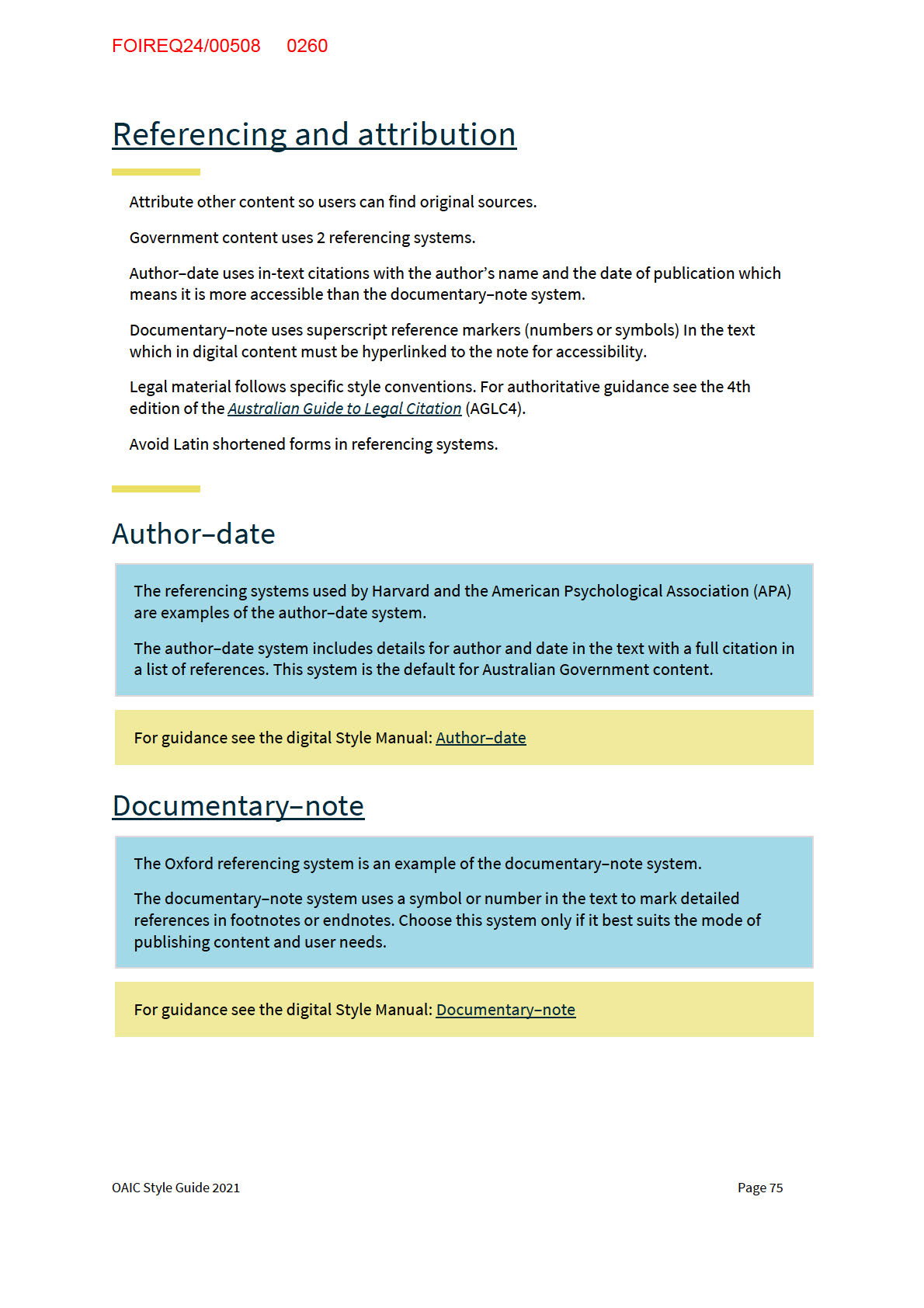
FOIREQ24/00508 0261
Legal material
There are different conventions for citing legal material. Follow one style consistently to
help people read and use the information. The OAIC follows the guidance in Style Manual on
how to cite legal material. For specific guidance on how to cite legal material in legal writing
and research, you may wish to use the 4th edition of the
Australian Guide to Legal Citation
(AGLC4). OAIC legal writing includes privacy determinations, Information Commissioner
review decisions and vexatious applicant declarations.
Cite legal material consistently and accurately
It’s important to cite legal sources in a consistent and accurate way across government.
The digital Style Manual gives common guidance for different types of legal material, including:
• bills and explanatory material
• Acts of parliament
• schedules
• delegated legislation
• cases and legal authorities
• treaties.
Use the correct legislation title
Unless it is obvious from the context:
• Put the title first when writing in-text citations, footnotes and endnotes.
• Follow the title with the rest of the citation.
Use the following databases to find the authorised titles of legislation from each Australian
jurisdiction.
Commonwealth
• Federal Register of Legislation
States and territories
• ACT Legislation Register
• NSW legislation
• Northern Territory legislation
• Queensland legislation
• South Australian legislation
OAIC Style Guide 2021
Page 76
FOIREQ24/00508 0262
• Tasmanian legislation
• Victorian legislation and parliamentary documents
• Western Australian legislation
A useful way to track the history of legislation, particularly for historical material not
published online is to use the Office of Parliamentary Counsel (OPC) Legislation tables.
Bills and explanatory material
Cite bills and explanatory material using the right style to help people find the source
material.
Style for bill titles is roman type, title case
A bill is a draft Act introduced into parliament. A bill becomes an Act when the Governor-General
gives assent to the bill after the Senate and House of Representatives agree on its content.
Write the titles of bills in roman type, not italics.
Bills have a:
• short title (its name), which includes the year
• long title (a description).
In general, use the short title. Use title case (maximal capitalisation). There is no comma between
the title and year.
Use lower case for generic references to bills, regulations and ordinances. Use initial capitals for all
references to Acts.
Lower case is correct, unless the reference is to a specific bill
Always use an initial capital for the word ‘Bill’ when you write about a specific bill: ‘the Bill’, ‘this
Bill’.
If you are writing about 2 or more bills, use the lower case: ‘the bills’, ‘these bills’.
If you write about a bill or bills generally, use the lower case: ‘a bill’, ‘some bills’.
For bills, people are unlikely to find the lower case forms confusing. If there’s any chance the text
is unclear to users, use a capital ‘B’.
The basic unit of a bill is a clause (cl)
Bills contain clauses, which become sections when bills become Acts. Clauses can be divided into
subclauses, then into paragraphs and then into subparagraphs. Use lower case for these units of a
bill unless they begin a sentence.
OAIC Style Guide 2021
Page 77
FOIREQ24/00508 0263
Long bills have clauses grouped into parts, divisions and subdivisions. Always use an initial capital
for these units, for example ‘Part 1’.
Bills often contain schedules. These are not units but are components of bills, Acts and some
delegated legislation.
Units below clause level
Commonwealth bills refer to units below clause level using the smallest unit of text. This is a
convention used by the Office of Parliamentary Counsel in legislative drafting. Some jurisdictions
cite at clause level. Be guided by the type of content you’re writing, and its purpose and audience.
These citations specify the smallest unit of text:
– clause 9
– subclause 9(4)
– paragraph 9(4)(a)
– subparagraph 9(4)(a)(ii).
Other jurisdictions might cite the subparagraph as ‘clause 9(4)(a)(i )’. [A citation at clause
level]
Shortened forms for units
The shortened forms of ‘clause’ and ‘clauses’ are ‘cl’ and ‘cls’. Write them in lower case and
without a full stop.
The shortened forms of ‘subclause’ and ‘subclauses’ are ‘subcl’ and ‘subcls’.
The other units of bills mentioned above are also found in Acts.
You can use both the long and shortened forms of units for in-text citation and notes. To decide
which to use, think about the type of content, its users and the amount of legal material cited in it.
If the long form better helps people understand the text, use it.
Explanatory material titles use roman type, title case
Explanatory material includes explanatory memorandums and explanatory statements.
An explanatory memorandum is a document tabled in parliament with a bill. It explains the
objective of a proposed law and how it will operate. The Australian Government has provided
explanatory memorandums with all government bills since 1982.
An explanatory statement is a similar document that accompanies delegated legislation such as
regulations and determinations.
Write titles in roman type. Use title case for the titles of explanatory material.
OAIC Style Guide 2021
Page 78
FOIREQ24/00508 0264
Acts of parliament
Refer to Acts of parliament using the correct style so people can find the source material.
Choose when to cite the short and long titles, series numbers, jurisdiction and sections.
Style for Act titles is title case, not always italics
Use title case (maximal capitalisation) for the titles of Acts.
Use italics for the first mention of the title of an Act and roman text for subsequent mentions.
Use roman type for the titles of Acts in reference lists and other long lists. Blocks of italics
are difficult to read.
The year the legislation is first enacted forms part of the title. Don’t use a comma before the year.
Include all the words in the title. If the title begins with ‘The’, ‘An’ or ‘A’, make sure you include it.
If the Act’s title has a number, include the number exactly as written. The contraction ‘No.’ retains
the full stop, which is an exception to the general rule for the shortened form for ‘number’.
Supply Act (No. 1) 2019–2020
An Act has a short title (its name) and long title (a description). Both appear after the list of
contents in the text of the Act. The long title appears as a heading before section 1 of the Act. The
short title is named in section 1.
An Act relating to Currency, Coinage and Legal Tender [Long title]
Part I—Preliminary
1 Short title
This Act may be cited as the
Currency Act 1965. [Short title]
At first mention, use the short title in italics
The first time you name the Act in text, use the short title in italics.
The
Currency Act 1965 established the Royal Australian Mint to produce Australia’s
circulating coins. The Act also sets restrictions on amounts that can be paid in coins as
‘legal tender’.
OAIC Style Guide 2021
Page 79
FOIREQ24/00508 0265
After first mention, use the short title in roman type without the year
Always use the short title in italics the first time you cite the Act in your text.
If there are subsequent mentions of the Act, use the short title in roman type without the year.
Only add the shortened form in parentheses at the first mention if it does more than just remove
the year or the word ‘Act’ from the title.
Or use the informal title in roman type
Often, Acts also have a shorter informal title. This is usually an initialism or acronym of the short
title. At first mention, include the informal title in parentheses after the title. Use the informal title
after that.
Use title case and roman type for the informal title.
… in the
Public Governance, Performance and Accountability Act 2013 (PGPA Act). … Section
10 of the PGPA Act defines a Commonwealth entity as …
Freedom of Information Act 1982 (FOI Act)
Each Act has a series number to use in citations
Acts are also identified by series. Every Act made in a year is given a number starting at 1.
The series appears in the text of the Act immediately under the title, for example ‘Act No. 137 of
1979’.
Using the series in general text helps people identify the particular Act and find it in the Legislation
Register. Series are also used in annotations and in notes.
The
Australian Citizenship Act 2007, by virtue of amendments made in 2013 (Act No. 57 of
2013), gives the Minister the discretionary power to …
Jurisdiction is an important detail
Where confusion may arise, it may be helpful to identify the jurisdiction of an Act – that is, whether
it is a Commonwealth or a state or territory Act – by inserting the abbreviation for the jurisdiction
in roman type in brackets after the title.
Privacy Act 1988 (Cth)
Privacy and Personal Information Protection Act 1998 (NSW)
An initial capital is correct, whether the reference is generic or not
Always use capitals for the words ‘Act’ and ‘Acts’ when you write about Acts of parliament.
OAIC Style Guide 2021
Page 80
FOIREQ24/00508 0266
The basic unit of an Act is a section (s)
An Act contains sections, which are often divided into smaller units called subsections.
Subsections might be divided into paragraphs and subparagraphs.
The units of an Act may be written in long form or shortened form (an abbreviation or
contraction), depending on the context. Never use a full stop after the shortened form.
In formal and standard content, the OAIC cites at section level and uses the shortened form
‘s’ for section.
An exception to this approach is content primarily aimed at non-legal audiences where we
use the long form ‘section’. Examples include our NDB reports and COVIDSafe reports.
The Australian Information Commissioner can issue guidelines about the operation of the
Freedom of Information Act 1982 (FOI Act) under s 93A. [Website content]
If the Commissioner believes an offence relating to COVIDSafe or COVID app data may have
been committed, under section 94U the Commissioner must discontinue that part of the
investigation and inform the Australian Federal Police or Commonwealth Director of Public
Prosecutions. [COVIDSafe Report May-November 2020]
Sections are usually grouped into parts, divisions and subdivisions. An Act only has subdivisions if
there are divisions. Both the
Freedom of Information Act 1982 and the
Privacy Act 1988 are divided
into parts and there are divisions within those parts. Some larger Acts – for example, the
Criminal
Code Act 1995 – contain chapters.
Always use an initial capital for a specific reference to a ‘Chapter’, ‘Part’, ‘Division’ or ‘Subdivision’.
OAIC Style Guide 2021
Page 81
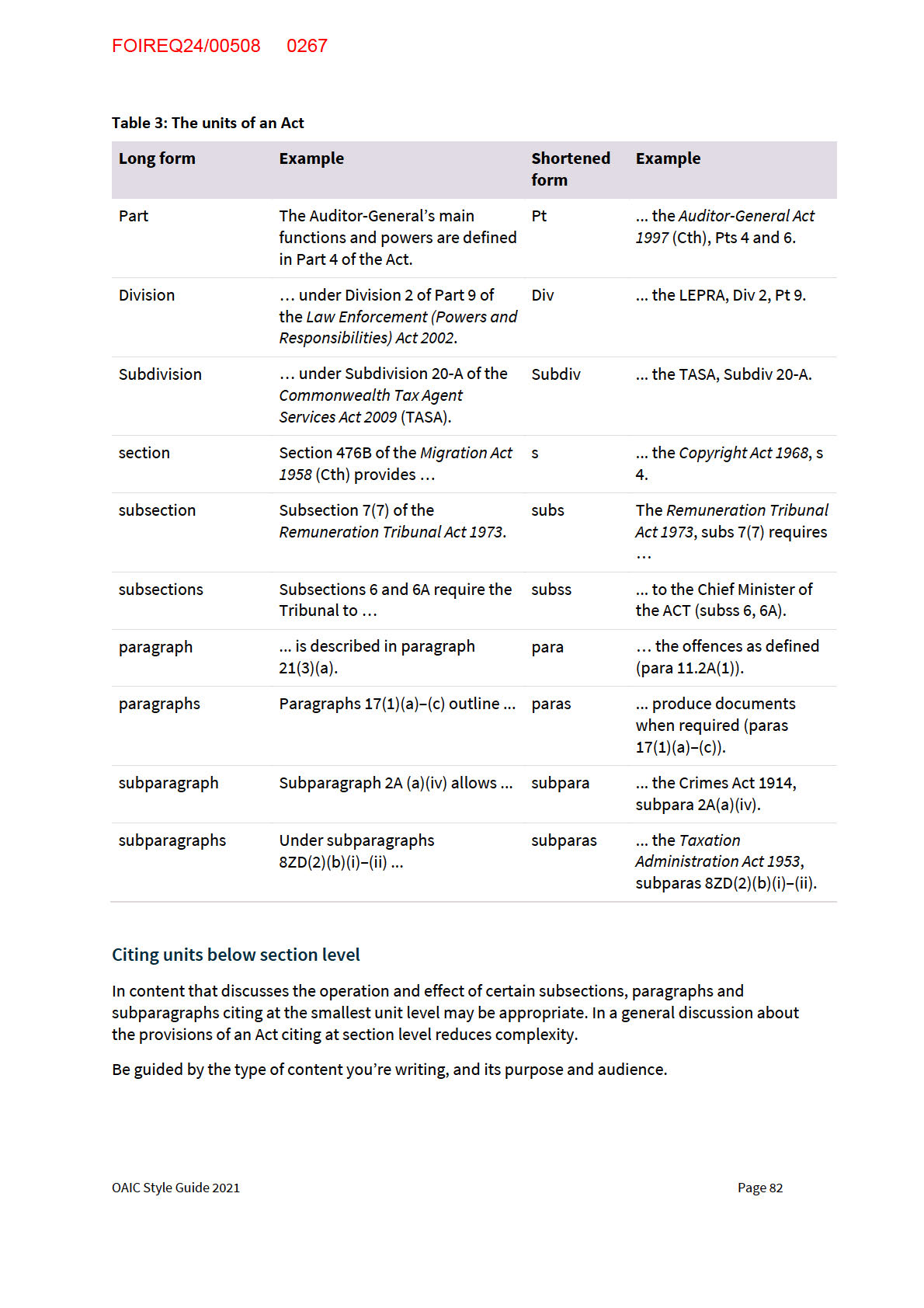
FOIREQ24/00508 0268
These citations specify the smallest unit of text:
– section 113V
– subsection 113V(4)
– paragraph 113V(4)(a)
– subparagraph 113V(4)(a)(i ).
For guidance see the digital Style Manual:
Titles of Acts from other countries are in roman type
Reference to Australia’s Constitution needs capitalisation only
Schedules
Refer to schedules that appear at the end of legislation using style conventions. Follow the
drafting rules for amending and non-amending schedules so people can find the source
information.
Schedules are components of legislation
Schedules are components (not units) of bills, Acts and some instruments. They appear at the end
of legislation. Schedules are either amending or non-amending.
Amending schedules are more common. There are drafting rules about their use and the order in
which each schedule appears.
Most amending schedules list amendments to other Acts, bills and instruments that will take effect
when the legislation commences. Some contain other provisions such as savings and transitional
arrangements.
Non-amending schedules have many different purposes. Units of non-amending schedules are
named differently depending on the purpose. Non-amending schedules sometimes include text
that could be contained in the body of the legislation as a section. In this case, the basic unit is a
clause. Cite at schedule level, not the basic unit level, for most content.
Style for schedule titles is an initial capital
Use capital ‘S’ for long and shortened forms of named schedules.
Always capitalise ‘Schedule’ or ‘Schedules’ when you write the title of schedules or refer to
particular schedules.
The shortened form is ‘Sch’ for singular and plural.
OAIC Style Guide 2021
Page 83
FOIREQ24/00508 0269
The basic unit of an amending schedule is an item
For most texts, you don’t need to identify the units of different types of schedules or to decide how
units should be cited. It is enough to cite at schedule level.
Amending schedules are divided into parts, then into divisions. Both are given arabic numerals –
for example, Part 1 Division 3. Divisions contain items divided into subitems, which are given
numbers in parentheses – (1), (2) and so on.
There is no shortened form for ‘item’ or ‘subitem’.
Delegated legislation
Follow the correct style to cite delegated legislation made under the authority of an Act.
This will help people find the source material.
Delegated legislation comes in many forms
Delegated legislation is made under the authority of an Act, not by the Act directly. For example,
parliament may delegate this authority to a minister, statutory bodies or office holders.
Regulations are the most common type of delegated legislation. There are many others, including:
• determinations
• ordinances
• proclamations
• orders
• rules
• by-laws
• standards
• principles.
Some jurisdictions refer to delegated legislation as ‘subordinate legislation’, ‘subsidiary
legislation’ or ‘statutory rules’.
Some, but not all, types of delegated legislation are legislative instruments. ‘Legislative
instrument’ is defined in section 8 of the
Legislation Act 2003. All legislative instruments are
registered on the Legislation Register. Regulations are legislative instruments.
The Legislation Register also contains notifiable instruments. These are not legislative, but are
notices about legal matters of interest to the public. An example is the Order to Call Out the
Australian Defence Force Reserves [No. 2], made during Australia’s bushfire crisis in 2020.
OAIC Style Guide 2021
Page 84
FOIREQ24/00508 0270
Style for regulations titles is roman type, title case
Use title case (maximal capitalisation) and roman type for the titles of regulations.
Always capitalise ‘Regulations’ or ‘Regulation’ when you write the title of regulations and refer to
particular regulations.
The basic unit of regulations is a regulation (reg)
Regulations are compilations made up of individual regulations. Each regulation might be divided
into subregulations.
Use lower case when citing an individual regulation or subregulation, unless they begin a
sentence.
Some titles are singular so check to make sure you write the title correctly. A singular regulation
still contains regulations and subregulations.
Cite the title exactly without altering the spelling. The year forms part of the title. There is no
comma between title and year.
Freedom of Information (Charges) Regulations 2019
Freedom of Information (Prescribed Authorities, Principal Officers and Annual Report)
Regulations 2017
Healthcare Identifiers Regulations 2010
My Health Records Regulation 2012
Privacy Regulation 2013
The shortened forms of regulations and subregulations are:
• reg
• regs
• subreg
• subregs.
Other delegated legislation follows title case, no italics
Style for all other titles of delegated legislation is the same as for regulations.
Use roman type and title case for citations that give the full title.
Use an initial capital for a reference to a specific instrument. Use lower case for generic references.
Determinations
Use the long form ‘Determination’ for in-text citations and notes.
OAIC Style Guide 2021
Page 85
FOIREQ24/00508 0271
Remuneration Tribunal (Members of Parliament) Determination No. 2 2019, Part 6
Financial Management Determination 2019 (Tas)
Use a capital ‘D’ when you refer to a particular determination or to determinations.
Use a lower case ‘d’ when you write about generic determinations.
Orders
Use the long forms ‘Order’ and ‘Orders’ for in-text citations and notes.
Marine Order 44 (Safe Containers) 2019
Use a capital ‘O’ when you refer to a particular order or to orders.
Use a lower case ‘o’ when you write about generic orders.
Ordinances
Use the long forms ‘Ordinance’ and ‘Ordinances’ for in-text citations and notes.
Social Welfare Ordinance 1964 (NT)
Use a capital ‘O’ when you refer to a particular ordinance.
Use a lower case ‘o’ when you write about generic ordinances.
Ordinances became known as Acts after the Northern Territory (in 1978) and the Australian Capital
Territory (in 1988) attained self-government.
Rules
A rule is made by judges or legislation setting out how a court will conduct its proceedings.
Anti-Money Laundering and Counter-Terrorism Financing Rules
Competition and Consumer (Consumer Data Right) Rules 2020
My Health Records Rule 2016
National Health (Privacy) Rules 2018
Privacy (Credit Related Research) Rule 2014
Privacy (Persons Reported as Missing) Rule 2014
Privacy (Tax File Number) Rule 2015
Use a capital ‘R’ when you refer to a particular rule or rules.
OAIC Style Guide 2021
Page 86
FOIREQ24/00508 0272
Use a lower case ‘r’ when you write about generic rules.
Units for rules are ‘rules’ and ‘subrules’.
Use lower case for their shortened forms:
• r (rule)
• subr (subrule)
• rr (rules)
• subrr (subrules).
Cases and legal authorities
Cite cases, rulings and determinations using the correct style. Accuracy helps people find
the source material. Specify the law report or online legal authority that hosts the relevant
judgment or decision.
Style for case names is title case, not always italics
A case is a matter to be settled at law. It is also a proceeding in a court of law. Legal authorities are
published sources of legal reasoning, doctrine and rulings made by courts and similar bodies.
The people or organisations named in the case are known as ‘parties’. Capitalise the names of the
parties but use a lower case ‘v’ between the party names. There is no full stop after ‘v’.
Case names have this basic form:
Party v Party.
Write the name of the case in italics. This rule is for case names that are mentioned briefly in
general text.
Use roman type for cases in reference lists and other long lists. Blocks of italics are difficult to read.
Always write the names as they appear in your source.
The abbreviated title is in italics
Cases are often known by an abbreviated title. On first mention of the case name, follow it with the
abbreviated title in parentheses. Write this title in italics and use title case. You can then use the
abbreviated title throughout the content. Do not capitalise ‘the case’ or ‘this case’.
… the important case in the High Court,
Commonwealth v Tasmania (
Tasmanian Dam Case).
The case saw the Commonwealth …
OAIC Style Guide 2021
Page 87
FOIREQ24/00508 0273
For guidance see the digital Style Manual:
The full citation gives users detail they might need
Decisions are either reported or unreported
Civil and criminal case titles have different elements
Subsequent citations in notes use the first party
Pinpoint citations use ‘at’ for page and paragraph numbers
Decisions can differ between judges or magistrates
Titles for Commonwealth tribunal decisions are in italics
Titles for Tax Commissioner rulings have unique elements
Treaties
Treaties are made under international law. Follow the correct style to help people to access
titles, series information and detailed citations.
For guidance see the digital Style Manual:
Treaty citations need the correct title and series information
Style for treaty titles is roman type, title case
Detailed citations for treaties have many elements
Authoritative reports
Case citations rely on authorised and unauthorised law report series. Use the correct
abbreviations for Australian law report series.
For guidance see the digital Style Manual:
Cite an authorised law report if one is available
Use common abbreviations for authorised reports
Use standard abbreviations for unauthorised reports
OAIC Style Guide 2021
Page 88
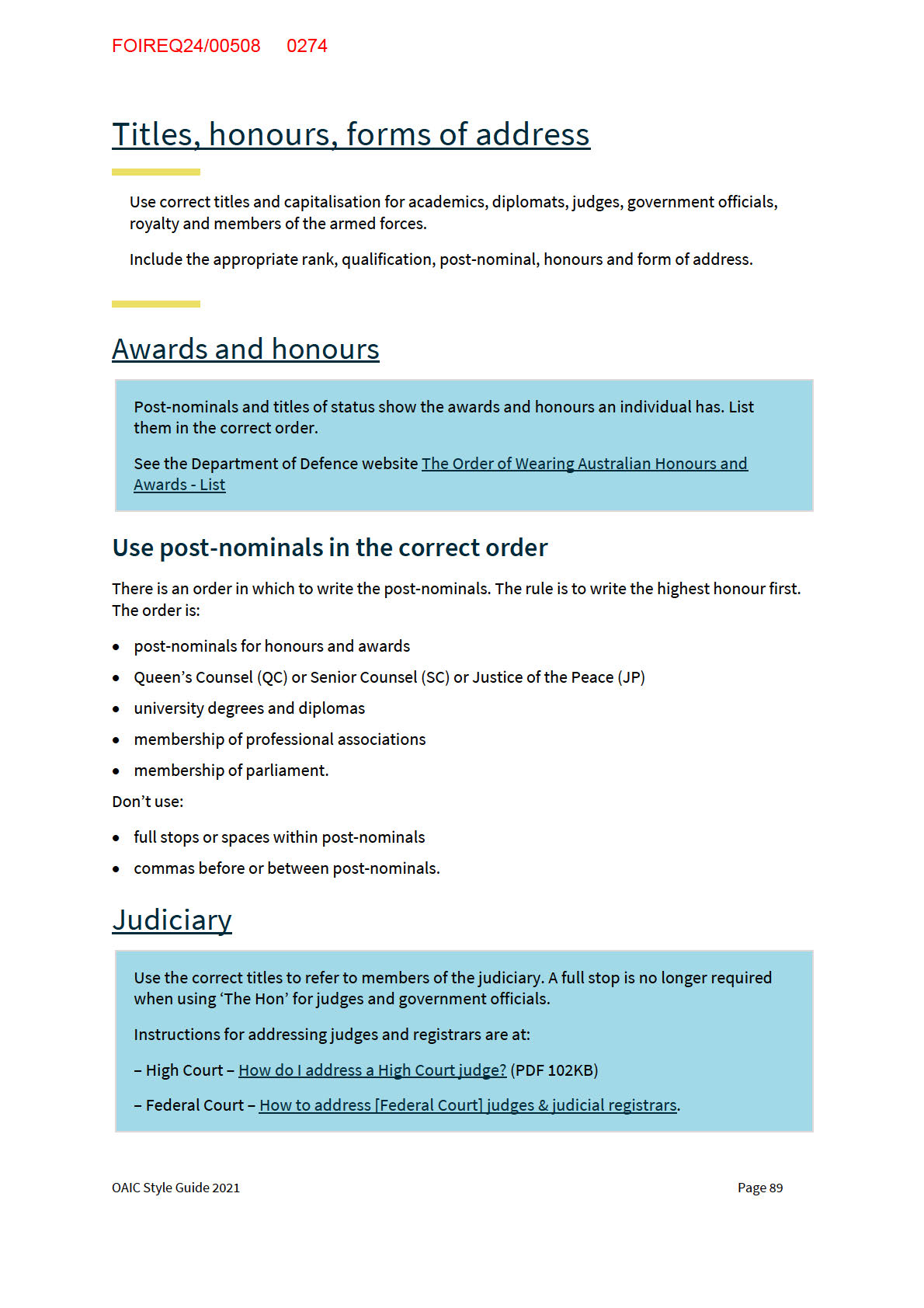
FOIREQ24/00508 0275
See the digital Style Manual: Judiciary
Use the correct form to refer to judges and magistrates
Refer to judges of the following courts as ‘Justice’ and use the title ‘The Honourable’:
• High Court
• Federal Court
• Family Court of Australia
• supreme courts in the states and territories.
Judges of these courts retain the title ‘The Honourable’ for life.
Use the titles ‘Your Honour’, ‘His Honour’ or ‘Her Honour’ for judges of:
• district courts
• county courts.
• High Court and Federal Court
Members of Australian parliaments and councils
Refer to members of Australian parliaments and councils in the correct style.
See Parliament of Australia website instructions – How to address Senators and Members
Capitalise titles for current senators and members of the
Australian Parliament
Write these titles as follows:
• the Prime Minister
• the President of the Senate
• the Speaker of the House of Representatives
• ministers (Senate)
• ministers (House of Representatives)
• assistant ministers (Senate)
• assistant ministers (House of Representatives)
• senators
• members (House of Representatives).
People elected to the upper house take the title ‘Senator’ before their given name.
OAIC Style Guide 2021
Page 90
FOIREQ24/00508 0276
Members of the House of Representatives take the initialism ‘MP’ after their name. Write it after
any other post-nominals. Don’t use commas before or between post-nominals.
Address certain office holders of the Australian Parliament as
‘Honourable’
Use the title ‘Honourable’ for ministers (including the prime minister) and parliamentary
secretaries in the Australian Parliament. The title is given to these office holders because they are
members of the Federal Executive Council. They retain the title for life.
The abbreviation for ‘Honourable’ is ‘Hon’ without a full stop.
Use the title ‘Senator’ before ‘the Honourable’ if the minister or parliamentary secretary is a
member of the Senate. The presiding officers and former office holders of state parliaments
The President of the Senate and the Speaker of the House of Representatives (the presiding
officers) use the title ‘Honourable’.
‘Honourable’ is also given to members of the Australian Parliament who are:
• former members of state ministries
• former presiding officers of state parliaments.
Senator the Hon Scott Ryan, President of the Senate
The Hon Tony Smith MP, Speaker of the House of Representatives
Senator the Hon Kristina Keneally [Former premier of NSW]
Address the Attorney-General and Minsters correctly
In formal emails and letters to a minister:
• open with ‘Dear Attorney’ when writing to the Attorney-General
• ‘Dear Minister’ when writing to the Minster for Health and Aged Care.
• conclude with ‘Yours sincerely’.
You should not use a comma after either the salutation or the sign-off.
For guidance see the digital Style Manual:
Use the appropriate form for members of state and territory parliaments
Address mayors and members of local governments with the correct title
OAIC Style Guide 2021
Page 91
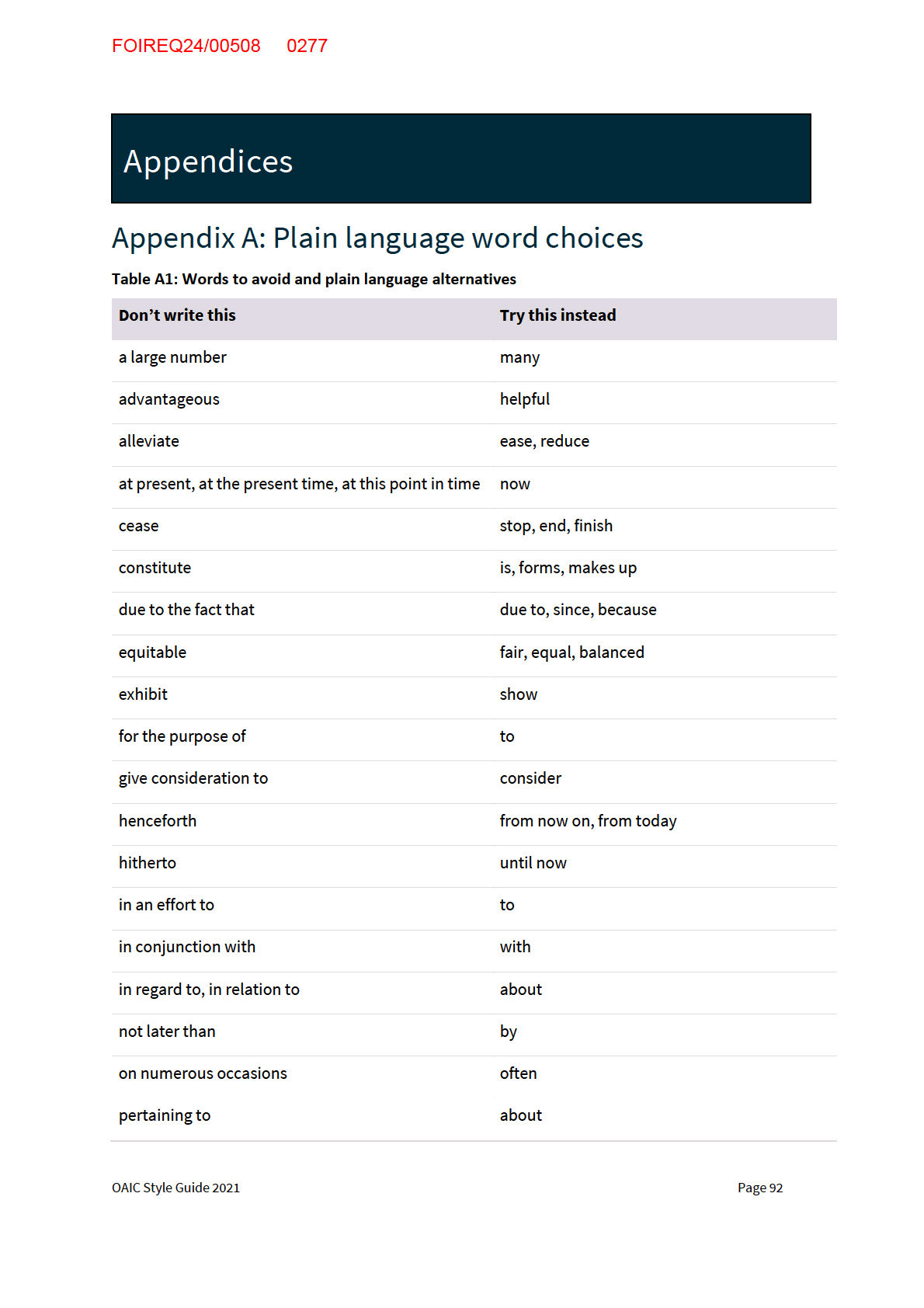
FOIREQ24/00508 0278
retain
keep
subsequent to
after
the majority of
most
thereafter
afterwards
until such time as
until, when
utilise
use
with a view to
to, so that
without further delay
now, immediately
OAIC Style Guide 2021
Page 93
FOIREQ24/00508 0279
Appendix B: Abbreviations
OAIC standard abbreviations
ACAPS
Australian Community Attitudes to Privacy Survey
APP
Australian Privacy Principles
APPA
Asia Pacific Privacy Authorities
CBPR
Cross Border Privacy Rules
CDR
Consumer Data Right
CR
Credit Reporting
DPI
Digital Platforms Inquiry
EDR
External Dispute Resolution
EM
Explanatory Memorandum
FCA
Federal Circuit Court
FOI
Freedom of Information
FOI Act
Freedom of Information Act 1982 (Cth)
IC review
Information Commissioner review
ICON
Information Contact Officer Network
IoT
Internet of Things
IP
Internet Protocol
IPPs
Information Privacy Principles
IPS
Information publication scheme
MAC
Media Access Control
MOU
Memorandum of Understanding
NDB scheme
Notifiable Data Breaches scheme
NPPs
National Privacy Principles
OAIC
Office of the Australian Information Commissioner
PAA
Privacy Authorities Australia
PAW
Privacy Awareness Week
PCO
privacy contact officer
PI
personal information, as under the Privacy Act
OAIC Style Guide 2021
Page 94
FOIREQ24/00508 0280
PIA
privacy impact assessment
PID
Personal Information Digest
also PID
public interest disclosure (aka whistleblowing)
RFQ
request for quotation
RFT
request for tender
TFN
tax file number
Other common abbreviations
Government agencies
ABS
Australian Bureau of Statistics
ACCC
Australian Competition and Consumer Commission
ACMA
Australian Communications and Media Authority
ADHA
Australian Digital Health Agency
AFSA
Australian Financial Security Authority
AGIMO
Australian Government Information Management Office
AGS
Australian Government Solicitor
AHRC
Australian Human Rights Commission
ALRC
Australian Law Reform Commission
ASIC
Australian Securities and Investment Commission
ATO
Australian Taxation Office
CAG
Council of Attorneys-General
DVA
Department of Veterans’ Affairs
IAC
Information Advisory Committee
Credit reporting
ACL
Australian Consumer Law
CIF
Credit information file
D&B
Dun and Bradstreet
TCS
Tasmanian Collection Service
OAIC Style Guide 2021
Page 95
FOIREQ24/00508 0281
Complaint bodies and tribunals
AAT
Administrative Appeals Tribunal
AFCA
Australian Financial Complaints Authority
FWO
Fair Work Ombudsman
SCT
Superannuation Complaints Tribunal
TIO
Telecommunications Industry Ombudsman
Industry associations
ABA
Australian Bankers Association
ACCI
Australian Chamber of Commerce and Industry
ADMA
Australian Direct Marketing Association
Cuscal
Credit Union Services Corporation (Australia) Ltd
DIGI
Digital Industry Group Inc
International organisations
APEC
Asia-Pacific Economic Cooperation
EDPB
European Data Protection Board
GDPR
General Data Protection Regulation
ICCPR
International Covenant on Civil and Political Rights
ICO UK
Information Commissioner’s Office, UK
IGIS
Inspector-General of Intelligence and Security
ISO
International Standards Organisation
OECD
Organisation for Economic Co-operation and Development
UKAS
United Kingdom Accreditation Service
OAIC Style Guide 2021
Page 96
FOIREQ24/00508 0282
Appendix C: OAIC templates
Microsoft Word templates
The OAIC has a range of Microsoft Word templates for documents such as memos, executive briefs,
agendas and minutes.
You can find our templates by clicking on the ‘New’ tab on the left-hand panel when you open
Word and selecting ‘Shared’ files.
Some key features to help you put your document together include the OAIC ribbon elements and
styles, which are explained in the body of the template document.
Generic templates
The ‘Long document template’ is designed for documents that use up to 6 levels of headings.
Headings 3, 4, 5 and 6 should be used in proper hierarchy throughout the document. Heading 1 is
always the main title of the document.
The ‘Short document template’ allows for 2 heading levels.
In both the long and short document templates, you can pick different Cover pages based on your
publication type, such as Assessment or Report, Consultation, Guide or Submission. As well as
simplifying document creation for you, this ensures we have a consistent visual brand identity for
our agency.
You may wish to read our Brand Guidelines: D2020/010770
Custom templates
There are custom templates for legal decisions:
• FOI Reasons for Decision template
• Decision – vexatious applicant declaration template
• Privacy Determination and Reasons template.
Master slide deck
The master slide deck contains content we commonly share in external presentations and helps to
ensure the OAIC’s external messaging and tone are consistent.
The master slide deck is intended to be used as a starting point for presentations. The content
may need to be adjusted to best suit different presentation topics and audiences. All presentations
must be approved before delivery.
See the Master slide deck: D2021/002622
OAIC Style Guide 2021
Page 97


FOIREQ24/00508 0285
On [date], you sought IC review of the «RespondentClientAbbreviation»’s decision under
s 54L of the FOI Act.
[insert any other relevant background information, such as a revised decision under s 55G of
clarification of the issues in the IC review]
Scope of IC review
The issues in this IC review are [insert].
In forming my view as review officer, I have had regard to the following:
• the «RespondentClientAbbreviation»'s decision and reasons for decision
• [if relevant insert details of internal review decision / revised decision]
• [if relevant] an unedited copy of the documents identified as falling within the scope of
the request
• the FOI Act, in particular [insert section/s]
• the Guidelines issued by the Australian Information Commissioner under s 93A of the FOI
Act to which agencies must have regard in performing a function or exercising a power
under the FOI Act (FOI Guidelines), in particular paragraphs [insert]
• [if relevant] relevant case law, in particular [insert], and
• the parties' submissions.
[use heading to introduce discussion about the issues in
the IC review]
Discuss the following, using headings where appropriate:
- the applicant’s IC review application and/or submissions
- the agency/minister’s reasons for decision and submissions
- any evidence you have had regard to (e.g. the documents at issue, evidence of
searches)
- relevant sections of the FOI Act and paragraphs of the FOI Guidelines
- relevant IC review/AAT/Federal Court decisions
Discretion not to [undertake/continue to undertake] an IC
review
Under s 54W of the FOI Act, the Information Commissioner may decide not to undertake a
review, or not to continue to undertake a review, if the Information Commissioner is satisfied
2
FOIREQ24/00508 0286
that the IC review application is frivolous, vexatious, misconceived, lacking in substance or
not made in good faith.
[Insert reasons for your view about why the application is frivolous, vexatious, misconceived,
lacking in substance or not made in good faith].
For these reasons, I intend to recommend that the Information Commissioner exercises the
discretion to decide not to [undertake/continue to undertake] this IC review under s 54W,
because I am of the view that this IC review application is [frivolous, vexatious,
misconceived, lacking in substance or not made in good faith].
The delegate of the Information Commissioner will review all material before the OAIC in
deciding whether to exercise the discretion to decide [not to undertake a review/not to
continue to undertake a review] in this case.
In consideration of the above, it its open to you to withdraw you IC review application by
[@
2 weeks].
If you disagree with this proposed recommendation, please write to us by
[@ 2 weeks] and
advise us of your reasons. Your reasons will be taken into account before a decision is made
on whether to finalise this matter under s 54W.
If I do not hear from you by this date your IC review may be finalised under s 54W and you
will be notified of your review rights.
If you have any questions about this email, please contact me on
«InvestigativeOfficerPhoneBH» or by email «InvestigativeOfficerEMail». In all
correspondence please include OAIC reference «CaseNumber»
.
Yours sincerely
«InvestigativeOfficerFirstname» «InvestigativeOfficerSurname»
«InvestigativeOfficerPosition»
Freedom of Information
4 November 2024
3
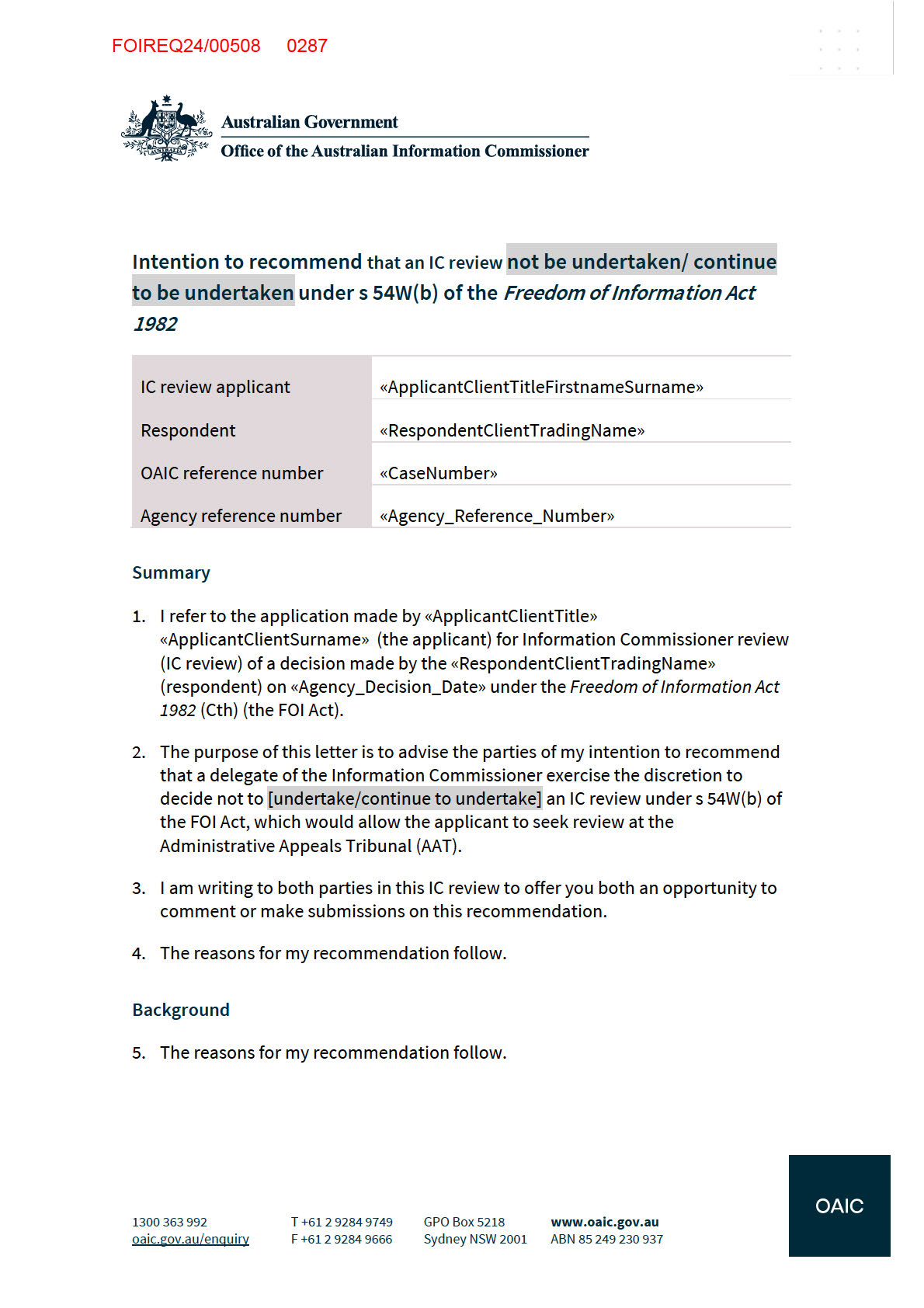
FOIREQ24/00508 0288
Discretion not to [undertake/continue to undertake] an IC review
6. The reasons for my recommendation follow.
7. The effect of such a decision would be to finalise this IC review application and
allow the applicant to apply directly to the AAT. The applicant would then have
28 days to lodge an application with the AAT in accordance with ordinary AAT
processes. AAT filing fees may apply.1
8. The discretion in s 54W(b) of the FOI Act may be exercised where the Information
Commissioner is satisfied that the interests of the administration of the FOI Act
make it desirable that the IC reviewable decision be considered directly by the
AAT, rather than initially by the Information Commissioner.
9. The Explanatory Memorandum to the Freedom of Information Amendment
(Reform) Bill 2009 which created s 54W(b) states:
One of the reasons for retaining a right of review to the AAT is that, as an experienced review
body, the AAT can properly deal with highly contested applications. This provision enables
the Information Commissioner to decline to undertake a review if satisfied it would be more
appropriate and efficient for the application to be made directly to the AAT.
10. This is also referred to in the Guidelines issued by the Australian Information
Commissioner under s 93A (FOI Guidelines) at [10.88] – [10.89], which state:
The Information Commissioner can decline to undertake a review if satisfied ‘that the
interests of the administration of the [FOI] Act make it desirable’ that the AAT consider the
review application (s 54W(b)). It is intended that the Commissioner will resolve most
applications. Circumstances in which the Commissioner may decide that it is desirable for the
AAT to consider a matter instead of the Commissioner continuing with the IC review include:
• where the IC review is linked to ongoing proceedings before the AAT or a court
• where there is an apparent inconsistency between earlier IC review decisions and AAT
decisions
• where, should the application progress to an IC review decision, the IC review decision is
likely to be taken on appeal to the AAT on a disputed issue of fact
• where the FOI request under review is of a level of complexity that would be more
appropriately handled through the procedures of the AAT
• where there may be a perceived or actual conflict of interest in the Commissioner
undertaking review, including where:
1 See, https://www.aat.gov.au/apply-for-a-review/freedom-of-information-foi/fees
2
FOIREQ24/00508 0289
o the FOI request under review was made to, or decided by, the
Information Commissioner or their delegate
o the FOI request or material at issue relate to specific functions exercised
by the Information Commissioner under the Privacy Act
o the applicant has active matters in other forums, including the AAT or
Federal Court and the Information Commissioner is the respondent
• where consideration by the AAT would further the objects of the FOI Act, particularly in
relation to the performance and exercise of functions and powers given by the FOI Act to
facilitate and promote public access to information, promptly and at the lowest
reasonable cost (s 3(4)).
The OAIC wil consult the parties involved in a matter before making a decision under
s 54W(b) to conclude an IC review.
11. The circumstances in which the Information Commissioner may consider it
desirable that the AAT consider the IC review application, as outlined in the FOI
Guidelines above, are not exhaustive. There will be circumstances that are not
listed where the Information Commissioner may deem it desirable to refer the
matter to the AAT.
12. The objects of the FOI Act provide that functions and powers under the FOI Act
are to be performed and exercised, as far as possible, to facilitate and promote
public access to information, promptly and at the lowest reasonable cost.
13. Further, in accordance with these objects, paragraph [10.18] of the FOI
Guidelines provides that IC reviews are intended to be a simple, practical and
cost-efficient method of external merits review.
[insert reasons for recommendation]
[Sample reasons for recommendation]
14. In this IC review, it is apparent that:
• The FOI decision under review is linked to ongoing proceedings currently
before the Administrative Appeals Tribunal. It is clear from the applicant’s
submissions in this IC review that the applicant is seeking access to
information about [provide details of proceedings].
• The FOI decision under review is complex and voluminous and resolving this
matter would require substantial allocation of OAIC resources. For example,
the scope of this IC review extends to various exemptions including [ss 22,
24A, 33, 42 and 47F] of the FOI Act and requires consideration of [number]
documents at issue.
3
FOIREQ24/00508 0290
• The exemption of s 33 of the FOI Act adds complexity to this matter because
before the Information Commissioner can determine that a document is not
an exempt document under s 33 of the FOI Act, she must first request the
Inspector-General of Intelligence to appear and give evidence on the damage
that would, or could reasonably be expected to be caused to the security or
the Commonwealth, the defence of the Commonwealth or the international
relations of the Commonwealth if access to the document were given in
accordance with the request (s 55ZB of the FOI Act), and
• Given the complexity of the IC review and the subject matter of the
documents requested, I consider that any IC review decision is likely to be
taken on appeal to the AAT on a disputed issue of fact. In my preliminary
view, this IC review could more appropriately be handled through the
procedures of the AAT.
15. For these reasons, I intend to recommend to a delegate of the Information
Commissioner that they exercise the discretion not to [undertake/continue to
undertake] an IC review under s 54W(b), as I am of the view that it is in the
interests of the administration of the FOI Act that this review be closed and that
the applicant be provided the opportunity of applying directly to the AAT for
review.
16. The delegate of the Information Commissioner will review all material before the
OAIC in deciding whether to exercise the discretion to decide not to
[undertake/continue to undertake] a review in this case.
Next steps
17. If you disagree with this proposed recommendation, please write to us by
[@ 2
weeks] and advise us of your reasons. Your reasons will be taken into account
before a decision is made on whether to finalise this matter under s 54W(b).
18. In the absence of a response by this date this IC review application may be
finalised under s 54W(b), and the parties will be notified of their review rights.
Yours sincerely
«InvestigativeOfficerFirstnameSurname»
«InvestigativeOfficerPosition»
Freedom of information Regulatory Branch
4 November 2024
4
